0001770121false00017701212023-09-122023-09-12
UNITED STATES
SECURITIES AND EXCHANGE COMMISSION
Washington, D.C. 20549
FORM 8-K
CURRENT REPORT
Pursuant to Section 13 or 15(d) of the
Securities Exchange Act of 1934
Date of Report (Date of earliest event reported): September 12, 2023
SANA BIOTECHNOLOGY, INC.
(Exact name of registrant as specified in its charter)
|
|
|
|
|
|
|
|
|
|
Delaware |
|
001-39941 |
|
83-1381173 |
(State or other jurisdiction of incorporation) |
|
(Commission File Number) |
|
(IRS Employer Identification Number) |
188 East Blaine Street, Suite 400
Seattle, Washington 98102
(Address of principal executive offices, including Zip Code)
Registrant’s telephone number, including area code: (206) 701-7914
Check the appropriate box below if the Form 8-K filing is intended to simultaneously satisfy the filing obligation of the registrant under any of the following provisions:
☐ Written communications pursuant to Rule 425 under the Securities Act (17 CFR 230.425)
☐ Soliciting material pursuant to Rule 14a-12 under the Exchange Act (17 CFR 240.14a-12)
☐ Pre-commencement communications pursuant to Rule 14d-2(b) under the Exchange Act (17 CFR 240.14d-2(b))
☐ Pre-commencement communications pursuant to Rule 13e-4(c) under the Exchange Act (17 CFR 240.13e-4(c))
Securities registered pursuant to Section 12(b) of the Act:
|
|
|
|
|
Title of each class |
|
Trading Symbol(s) |
|
Name of each exchange on which registered |
Common Stock, $0.0001 par value per share |
|
SANA |
|
The Nasdaq Stock Market LLC |
Indicate by check mark whether the registrant is an emerging growth company as defined in Rule 405 of the Securities Act of 1933 (§230.405 of this chapter) or Rule 12b-2 of the Securities Exchange Act of 1934 (§240.12b-2 of this chapter).
Emerging growth company ☒
If an emerging growth company, indicate by check mark if the registrant has elected not to use the extended transition period for complying with any new or revised financial accounting standards provided pursuant to Section 13(a) of the Exchange Act. ☐
Item 7.01 Regulation FD Disclosure.
At the Morgan Stanley 21st Annual Global Healthcare Conference on September 12, 2023, a company spokesperson of Sana Biotechnology, Inc. (the “Company”) announced that the Company expects to file an investigational new drug application for its SC291 product candidate in autoimmune diseases in the fourth quarter of 2023 and expects clinical data from the evaluation of SC291 in autoimmune diseases in 2024.
On September 13, 2023, the Company released an updated corporate presentation (the “Corporate Presentation”), a copy of which is furnished as Exhibit 99.1 to this Current Report on Form 8-K (this “Current Report”) and is incorporated by reference herein.
In accordance with General Instruction B.2 of Form 8-K, the information furnished with this Current Report, including Exhibit 99.1, shall not be deemed “filed” for purposes of Section 18 of the Securities Exchange Act of 1934, as amended (“Exchange Act”), or otherwise subject to the liabilities of that section, nor shall it be deemed incorporated by reference into any other filing under the Securities Act of 1933, as amended, or the Exchange Act, except as expressly set forth by specific reference in such a filing.
Forward-Looking Statements
This Current Report contains forward-looking statements, including regarding the timing or likelihood of the Company’s regulatory filings and the timing and availability of clinical data. These forward-looking statements reflect the Company’s views regarding current expectations and projections about future events and conditions and are based on currently available information. These forward-looking statements are not guarantees of future performance and are subject to risks, uncertainties and assumptions that are difficult to predict and the Risk Factors identified in the Company’s filings with the SEC, including the Company’s Annual Report on 10-K for the year ended December 31, 2022 and its Quarterly Report on Form 10-Q for the period ended June 30, 2023, and any subsequent Quarterly Reports on Form 10-Q; therefore, the Company’s actual results could differ materially from those expressed, implied or forecast in any such forward-looking statements. Expressions of future goals and expectations and similar expressions, including “may,” “will,” “should,” “could,” “aims,” “seeks,” “expects,” “plans,” “anticipates,” “intends,” “believes,” “estimates,” “predicts,” “potential,” “targets,” and “continue,” reflecting something other than historical fact are intended to identify forward-looking statements. Unless required by law, the Company undertakes no obligation to update publicly any forward-looking statements, whether as a result of new information, future events, or otherwise. However, readers should carefully review the reports and documents the Company files or furnishes from time to time with the SEC, particularly its Annual Reports on Form 10-K, Quarterly Reports on Form 10-Q, and Current Reports on Form 8-K.
Item 9.01 Financial Statements and Exhibits.
(d) Exhibits
See the Exhibit Index below, which is incorporated by reference herein.
EXHIBIT INDEX
SIGNATURES
Pursuant to the requirements of the Securities Exchange Act of 1934, the registrant has duly caused this report to be signed on its behalf by the undersigned thereunto duly authorized.
|
|
|
|
|
|
Sana Biotechnology, Inc. |
|
|
|
|
Date: September 13, 2023 |
|
By: |
/s/ Nathan Hardy |
|
|
|
Nathan Hardy |
|
|
|
Executive Vice President and Chief Financial Officer |
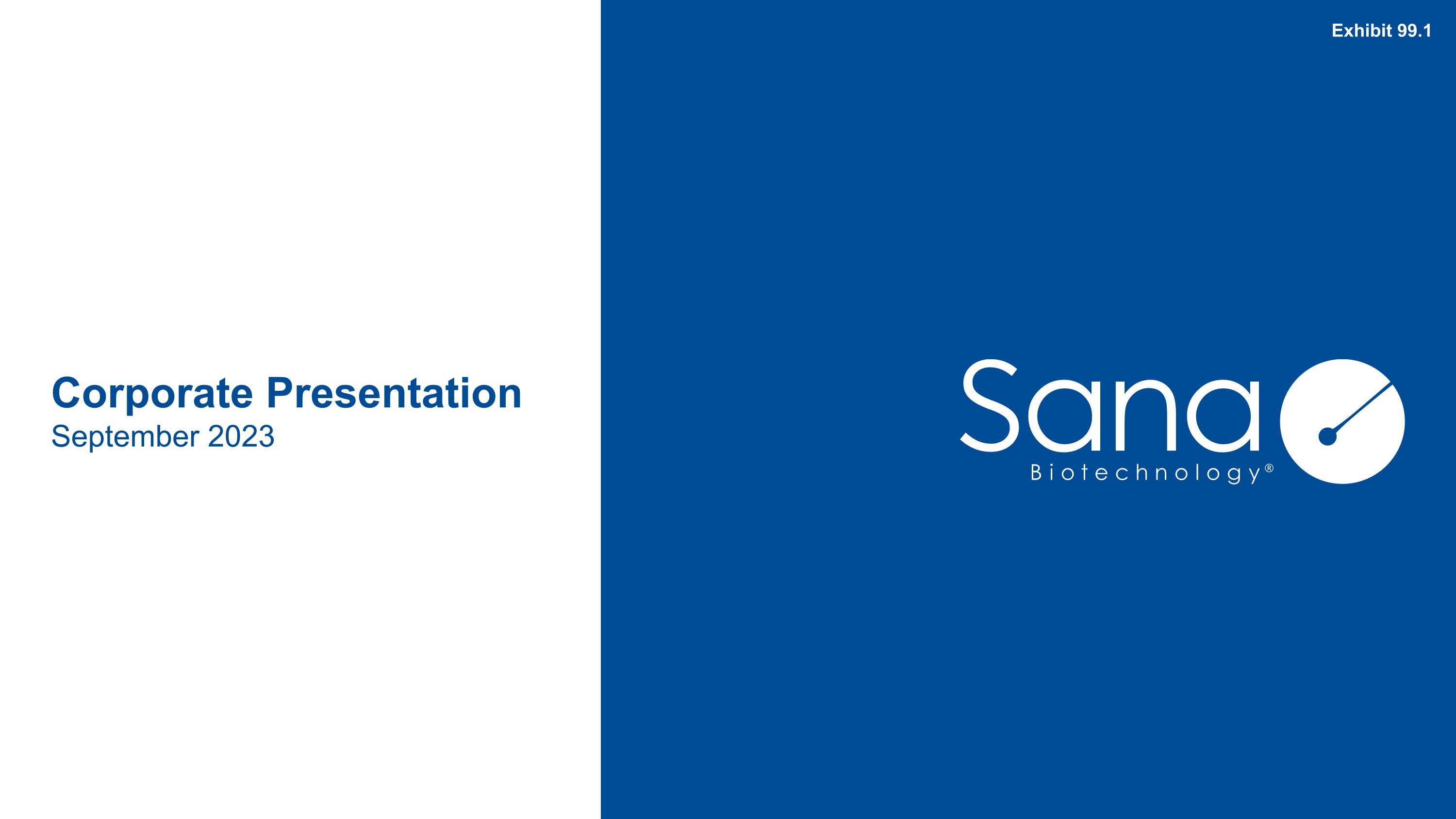
Corporate Presentation�September 2023 Exhibit 99.1
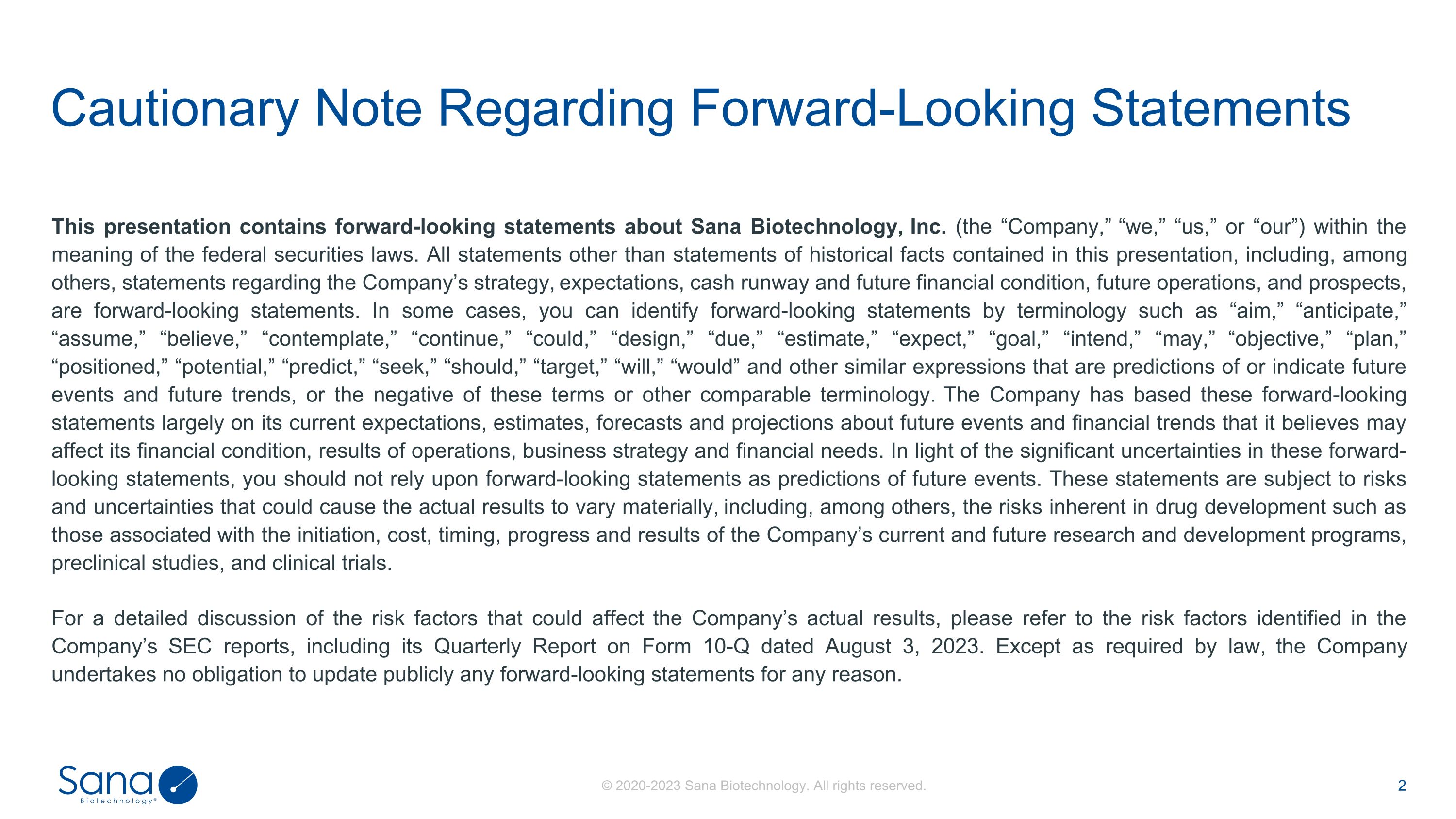
This presentation contains forward-looking statements about Sana Biotechnology, Inc. (the “Company,” “we,” “us,” or “our”) within the meaning of the federal securities laws. All statements other than statements of historical facts contained in this presentation, including, among others, statements regarding the Company’s strategy, expectations, cash runway and future financial condition, future operations, and prospects, are forward-looking statements. In some cases, you can identify forward-looking statements by terminology such as “aim,” “anticipate,” “assume,” “believe,” “contemplate,” “continue,” “could,” “design,” “due,” “estimate,” “expect,” “goal,” “intend,” “may,” “objective,” “plan,” “positioned,” “potential,” “predict,” “seek,” “should,” “target,” “will,” “would” and other similar expressions that are predictions of or indicate future events and future trends, or the negative of these terms or other comparable terminology. The Company has based these forward-looking statements largely on its current expectations, estimates, forecasts and projections about future events and financial trends that it believes may affect its financial condition, results of operations, business strategy and financial needs. In light of the significant uncertainties in these forward-looking statements, you should not rely upon forward-looking statements as predictions of future events. These statements are subject to risks and uncertainties that could cause the actual results to vary materially, including, among others, the risks inherent in drug development such as those associated with the initiation, cost, timing, progress and results of the Company’s current and future research and development programs, preclinical studies, and clinical trials. For a detailed discussion of the risk factors that could affect the Company’s actual results, please refer to the risk factors identified in the Company’s SEC reports, including its Quarterly Report on Form 10-Q dated August 3, 2023. Except as required by law, the Company undertakes no obligation to update publicly any forward-looking statements for any reason. Cautionary Note Regarding Forward-Looking Statements
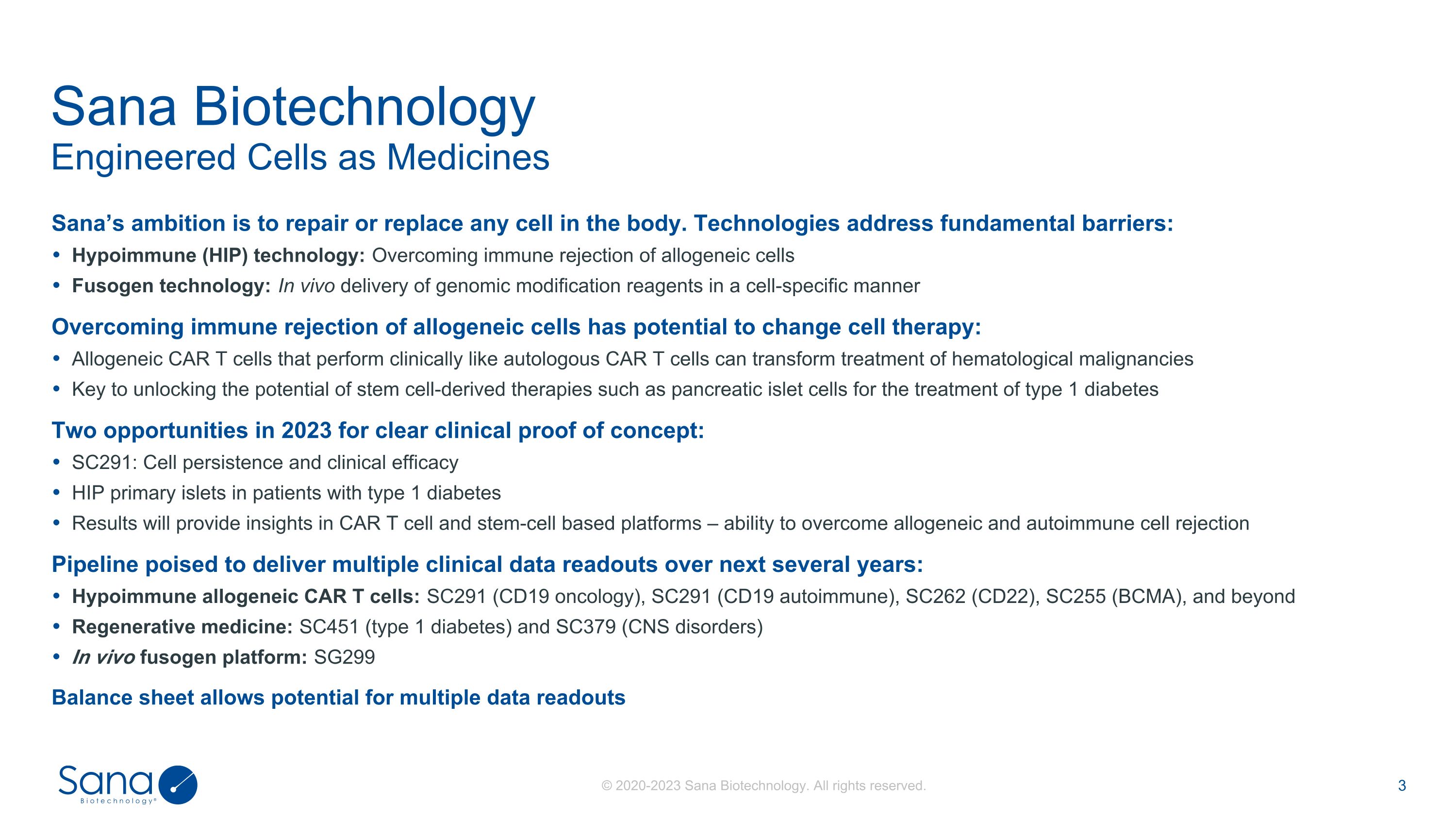
Sana’s ambition is to repair or replace any cell in the body. Technologies address fundamental barriers: Hypoimmune (HIP) technology: Overcoming immune rejection of allogeneic cells Fusogen technology: In vivo delivery of genomic modification reagents in a cell-specific manner Overcoming immune rejection of allogeneic cells has potential to change cell therapy: Allogeneic CAR T cells that perform clinically like autologous CAR T cells can transform treatment of hematological malignancies Key to unlocking the potential of stem cell-derived therapies such as pancreatic islet cells for the treatment of type 1 diabetes Two opportunities in 2023 for clear clinical proof of concept: SC291: Cell persistence and clinical efficacy HIP primary islets in patients with type 1 diabetes Results will provide insights in CAR T cell and stem-cell based platforms – ability to overcome allogeneic and autoimmune cell rejection Pipeline poised to deliver multiple clinical data readouts over next several years: Hypoimmune allogeneic CAR T cells: SC291 (CD19 oncology), SC291 (CD19 autoimmune), SC262 (CD22), SC255 (BCMA), and beyond Regenerative medicine: SC451 (type 1 diabetes) and SC379 (CNS disorders) In vivo fusogen platform: SG299 Balance sheet allows potential for multiple data readouts Engineered Cells as Medicines Sana Biotechnology
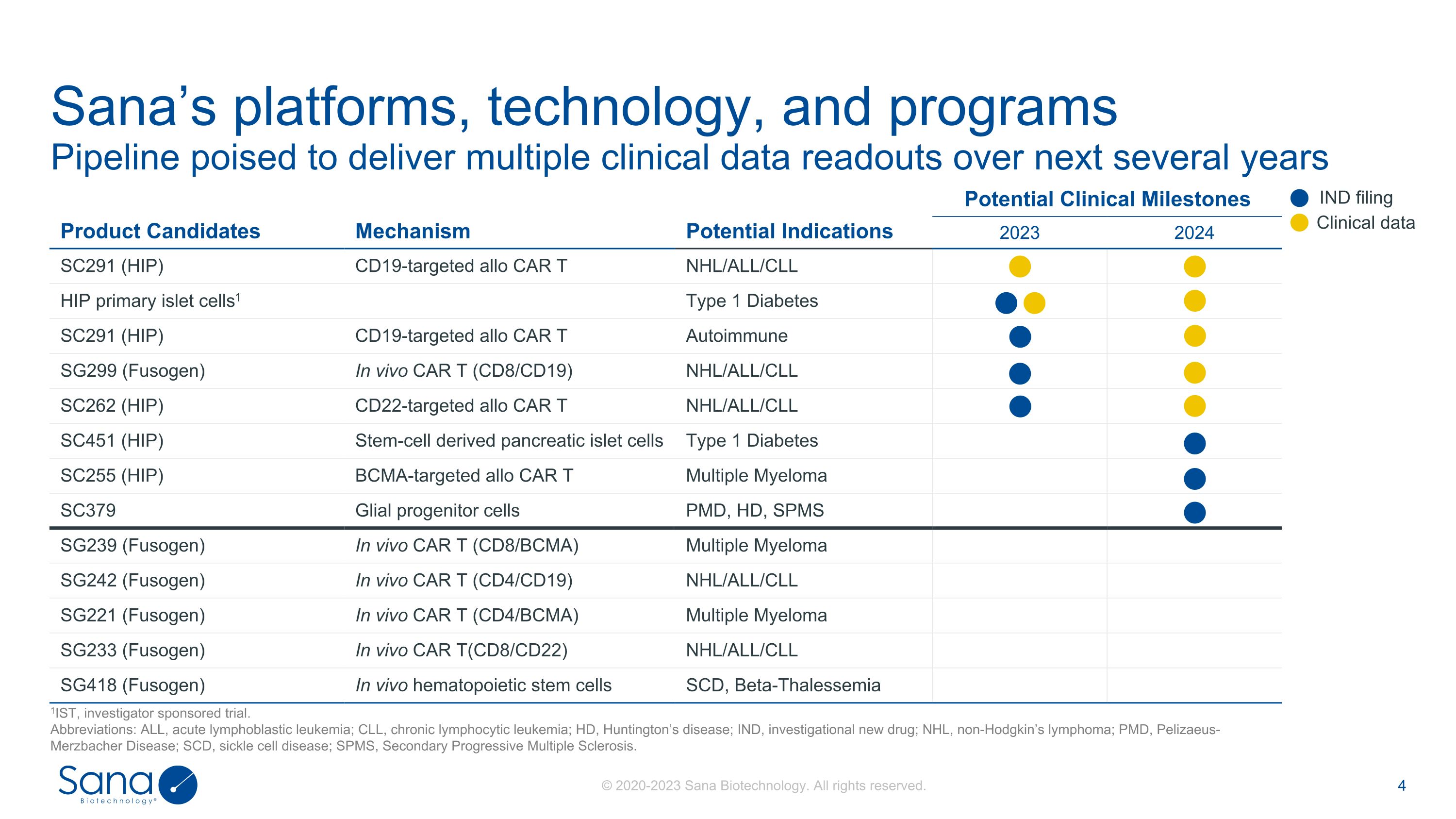
Pipeline poised to deliver multiple clinical data readouts over next several years Sana’s platforms, technology, and programs 1IST, investigator sponsored trial. Abbreviations: ALL, acute lymphoblastic leukemia; CLL, chronic lymphocytic leukemia; HD, Huntington’s disease; IND, investigational new drug; NHL, non-Hodgkin’s lymphoma; PMD, Pelizaeus-Merzbacher Disease; SCD, sickle cell disease; SPMS, Secondary Progressive Multiple Sclerosis. Product Candidates Mechanism Potential Indications Potential Clinical Milestones 2024 2023 2024 SC291 (HIP) CD19-targeted allo CAR T NHL/ALL/CLL HIP primary islet cells1 Type 1 Diabetes SC291 (HIP) CD19-targeted allo CAR T Autoimmune SG299 (Fusogen) In vivo CAR T (CD8/CD19) NHL/ALL/CLL SC262 (HIP) CD22-targeted allo CAR T NHL/ALL/CLL SC451 (HIP) Stem-cell derived pancreatic islet cells Type 1 Diabetes SC255 (HIP) BCMA-targeted allo CAR T Multiple Myeloma SC379 Glial progenitor cells PMD, HD, SPMS SG239 (Fusogen) In vivo CAR T (CD8/BCMA) Multiple Myeloma SG242 (Fusogen) In vivo CAR T (CD4/CD19) NHL/ALL/CLL SG221 (Fusogen) In vivo CAR T (CD4/BCMA) Multiple Myeloma SG233 (Fusogen) In vivo CAR T(CD8/CD22) NHL/ALL/CLL SG418 (Fusogen) In vivo hematopoietic stem cells SCD, Beta-Thalessemia IND filing Clinical data
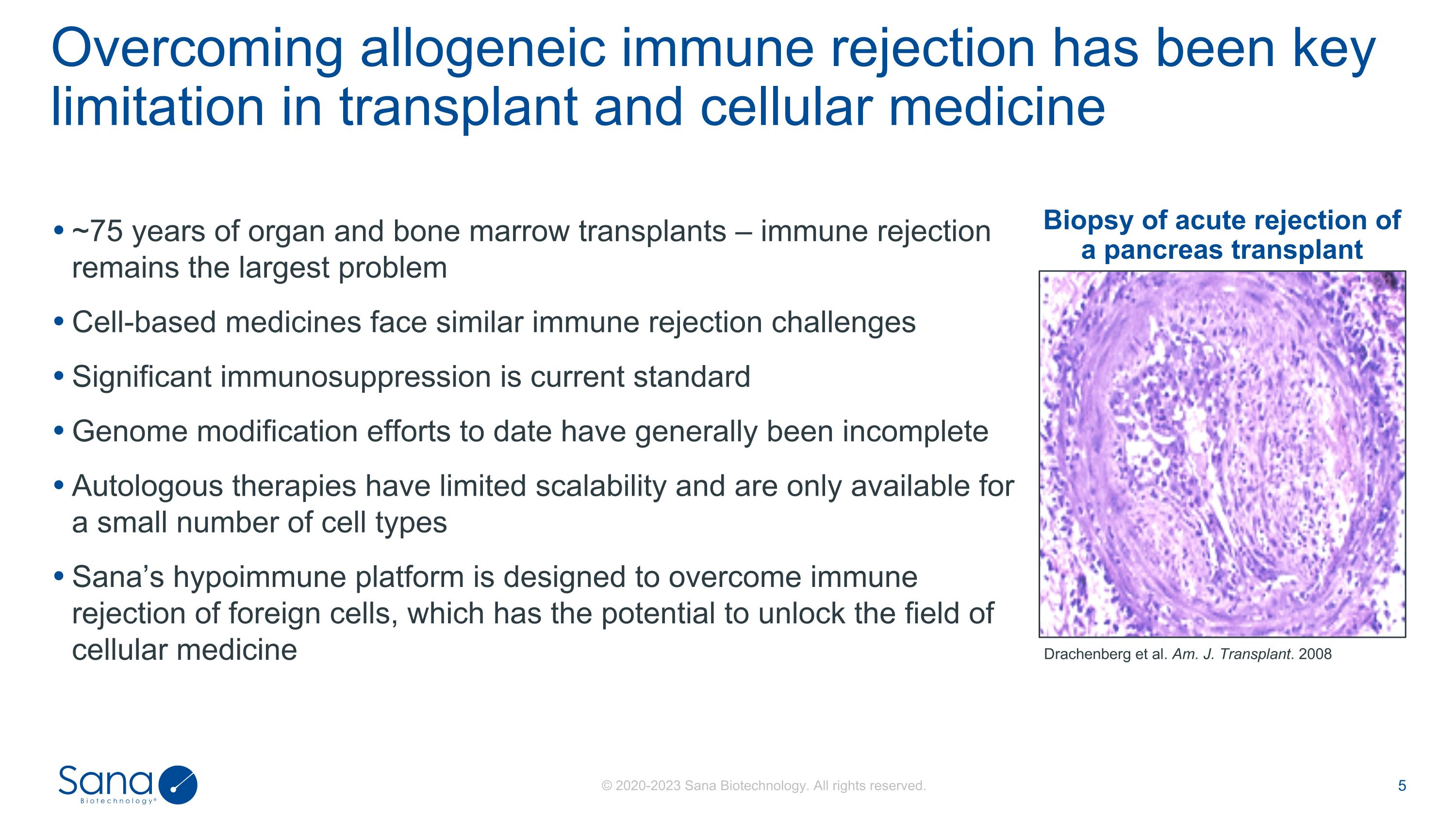
~75 years of organ and bone marrow transplants – immune rejection remains the largest problem Cell-based medicines face similar immune rejection challenges Significant immunosuppression is current standard Genome modification efforts to date have generally been incomplete Autologous therapies have limited scalability and are only available for a small number of cell types Sana’s hypoimmune platform is designed to overcome immune rejection of foreign cells, which has the potential to unlock the field of cellular medicine Overcoming allogeneic immune rejection has been key limitation in transplant and cellular medicine Drachenberg et al. Am. J. Transplant. 2008 Biopsy of acute rejection of a pancreas transplant
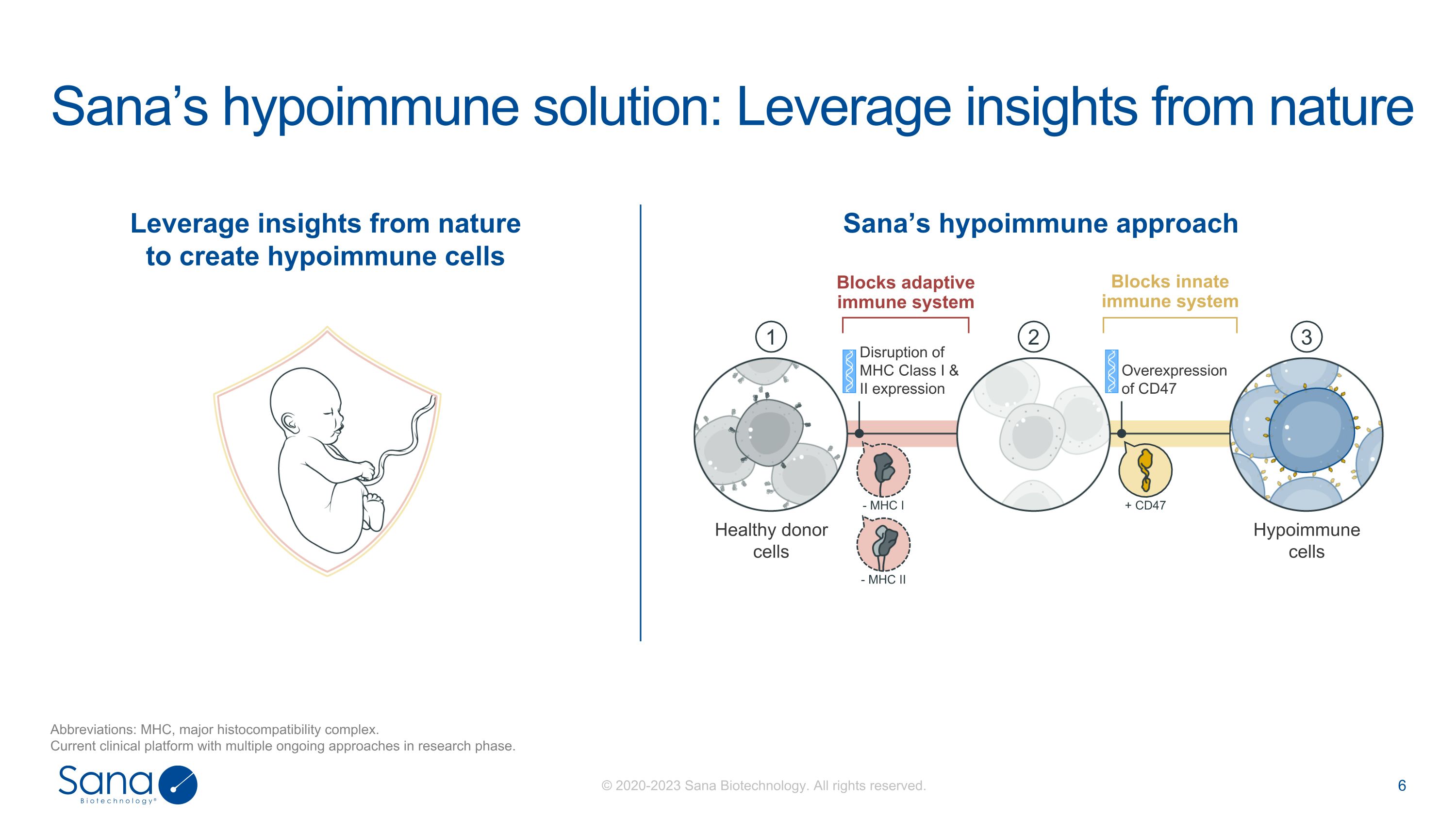
Sana’s hypoimmune solution: Leverage insights from nature Abbreviations: MHC, major histocompatibility complex. Current clinical platform with multiple ongoing approaches in research phase. Leverage insights from nature to create hypoimmune cells Sana’s hypoimmune approach + CD47 - MHC I - MHC II Healthy donor cells Hypoimmune�cells Disruption of MHC Class I &�II expression Overexpression of CD47 1 2 3 Blocks adaptive immune system Blocks innate immune system
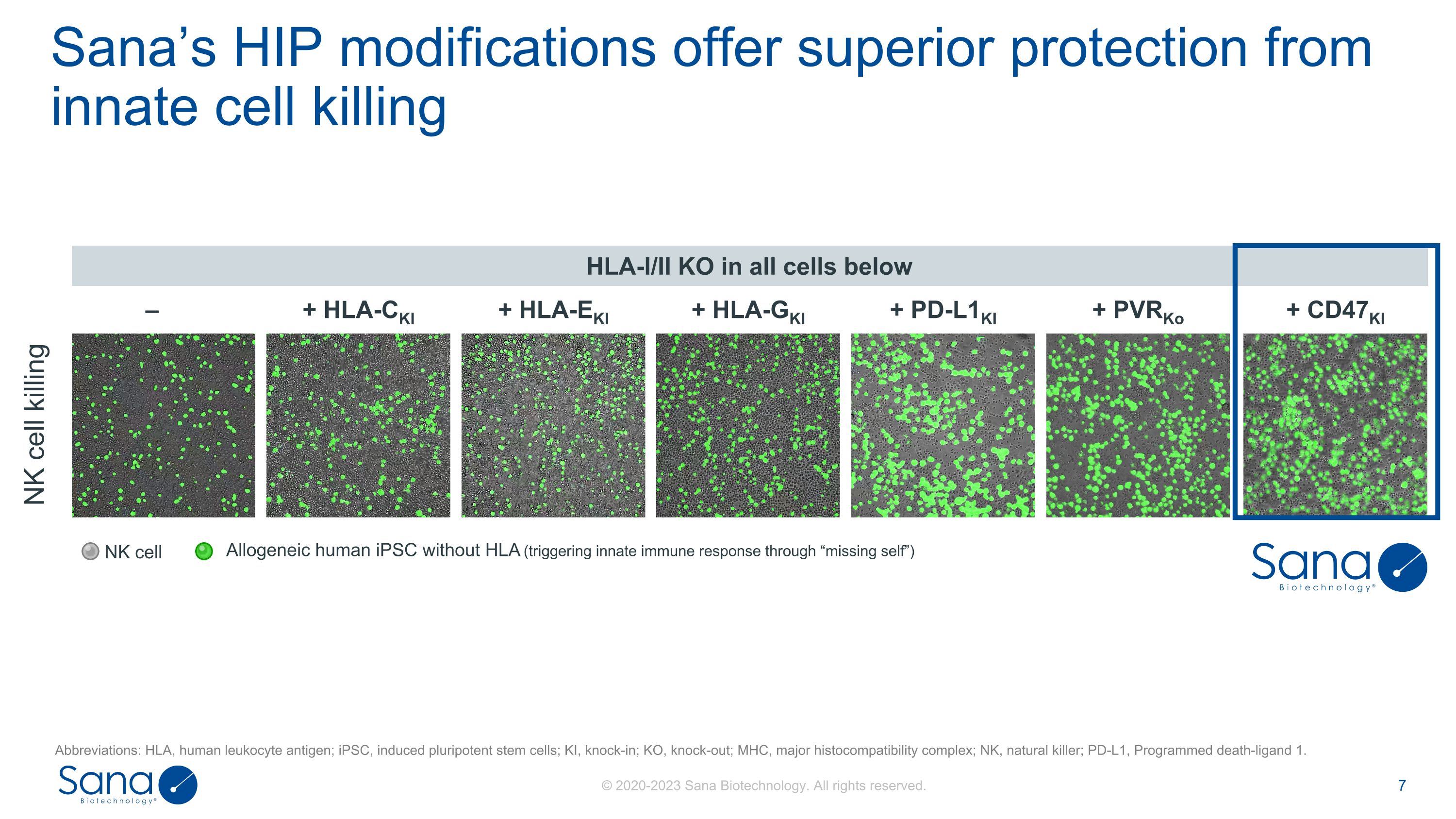
+ CD47KI + PD-L1KI + HLA-EKI + HLA-GKI + HLA-CKI HLA-I/II KO in all cells below – + PVRKo Sana’s HIP modifications offer superior protection from innate cell killing Allogeneic human iPSC without HLA (triggering innate immune response through “missing self”) Abbreviations: HLA, human leukocyte antigen; iPSC, induced pluripotent stem cells; KI, knock-in; KO, knock-out; MHC, major histocompatibility complex; NK, natural killer; PD-L1, Programmed death-ligand 1. NK cell killing NK cell
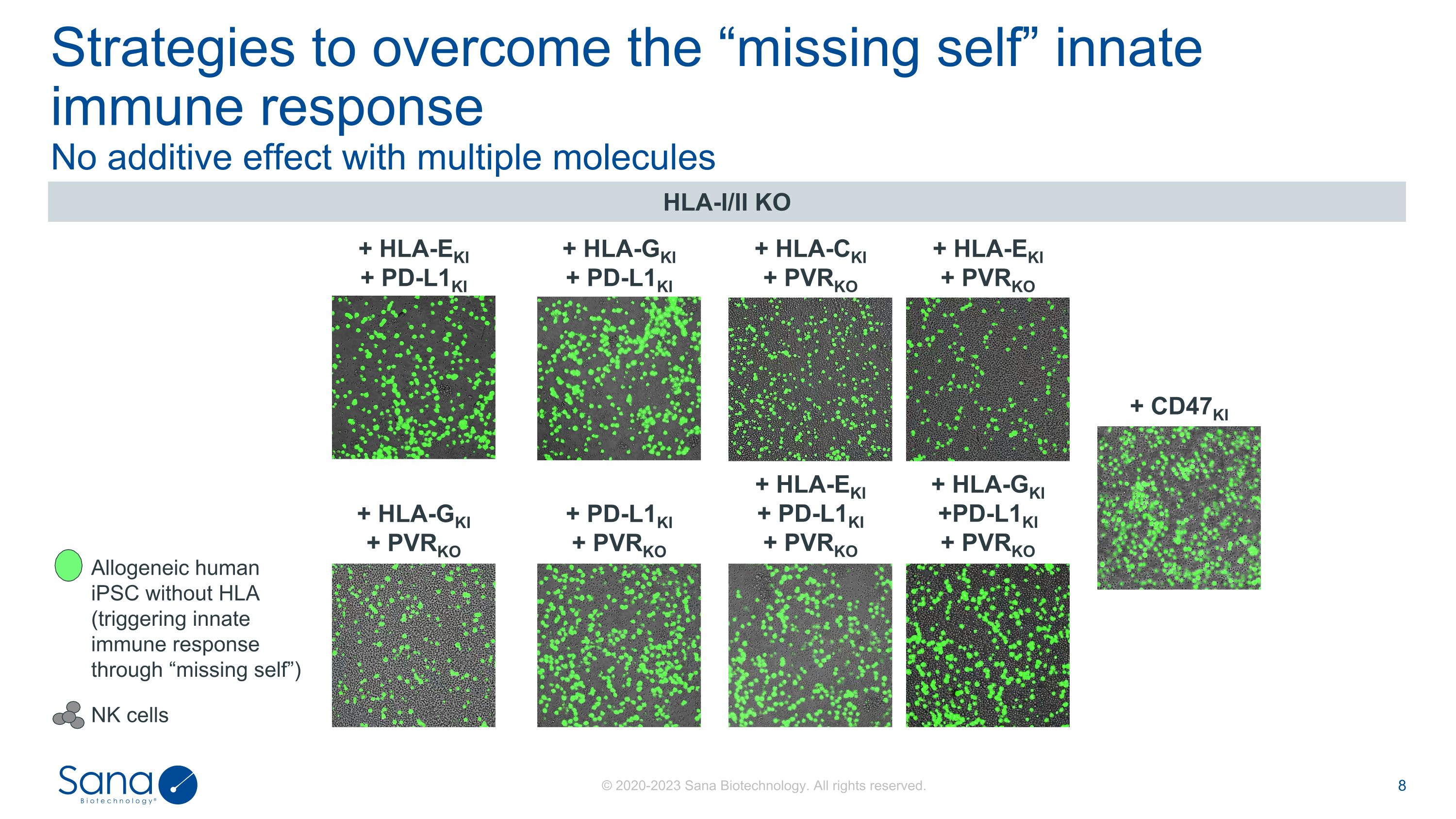
No additive effect with multiple molecules Strategies to overcome the “missing self” innate immune response HLA-I/II KO + CD47KI + HLA-CKI + PVRKO + HLA-EKI + PD-L1KI + PVRKO + HLA-EKI + PVRKO + HLA-GKI +PD-L1KI + PVRKO + HLA-GKI + PVRKO + HLA-EKI + PD-L1KI + PD-L1KI + PVRKO + HLA-GKI + PD-L1KI Allogeneic human iPSC without HLA (triggering innate immune response through “missing self”) NK cells
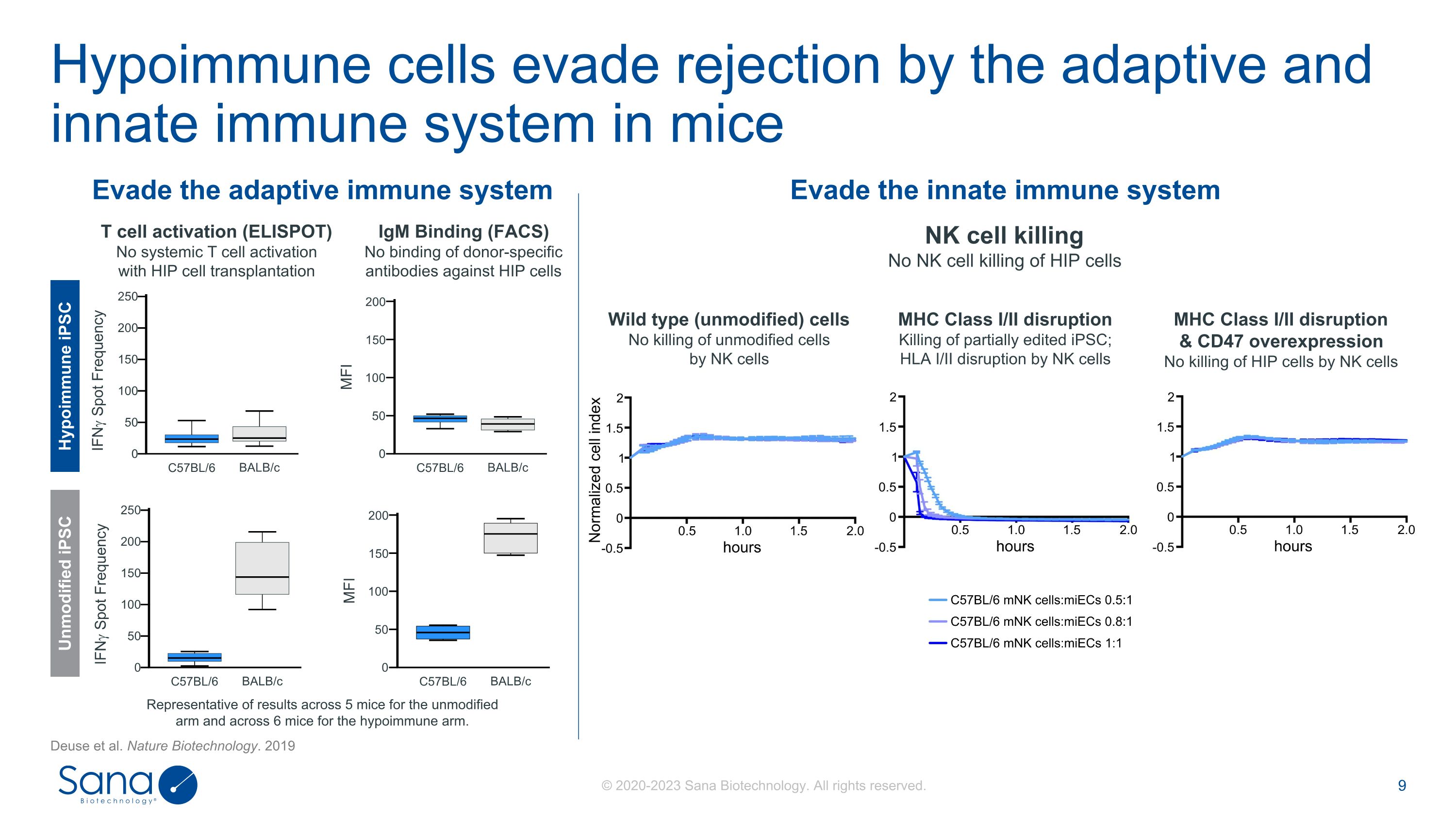
Hypoimmune cells evade rejection by the adaptive and innate immune system in mice Deuse et al. Nature Biotechnology. 2019 T cell activation (ELISPOT)�No systemic T cell activation�with HIP cell transplantation IgM Binding (FACS) No binding of donor-specific antibodies against HIP cells NK cell killing No NK cell killing of HIP cells Wild type (unmodified) cells No killing of unmodified cells�by NK cells MHC Class I/II disruption Killing of partially edited iPSC;�HLA I/II disruption by NK cells MHC Class I/II disruption �& CD47 overexpression No killing of HIP cells by NK cells Representative of results across 5 mice for the unmodified�arm and across 6 mice for the hypoimmune arm. Hypoimmune iPSC C57BL/6 BALB/c MFI 200 150 0 100 50 C57BL/6 BALB/c IFN Spot Frequency 250 200 0 100 50 150 Unmodified iPSC C57BL/6 BALB/c MFI 200 150 0 100 50 C57BL/6 BALB/c IFN Spot Frequency 250 200 0 100 50 150 Evade the adaptive immune system Evade the innate immune system
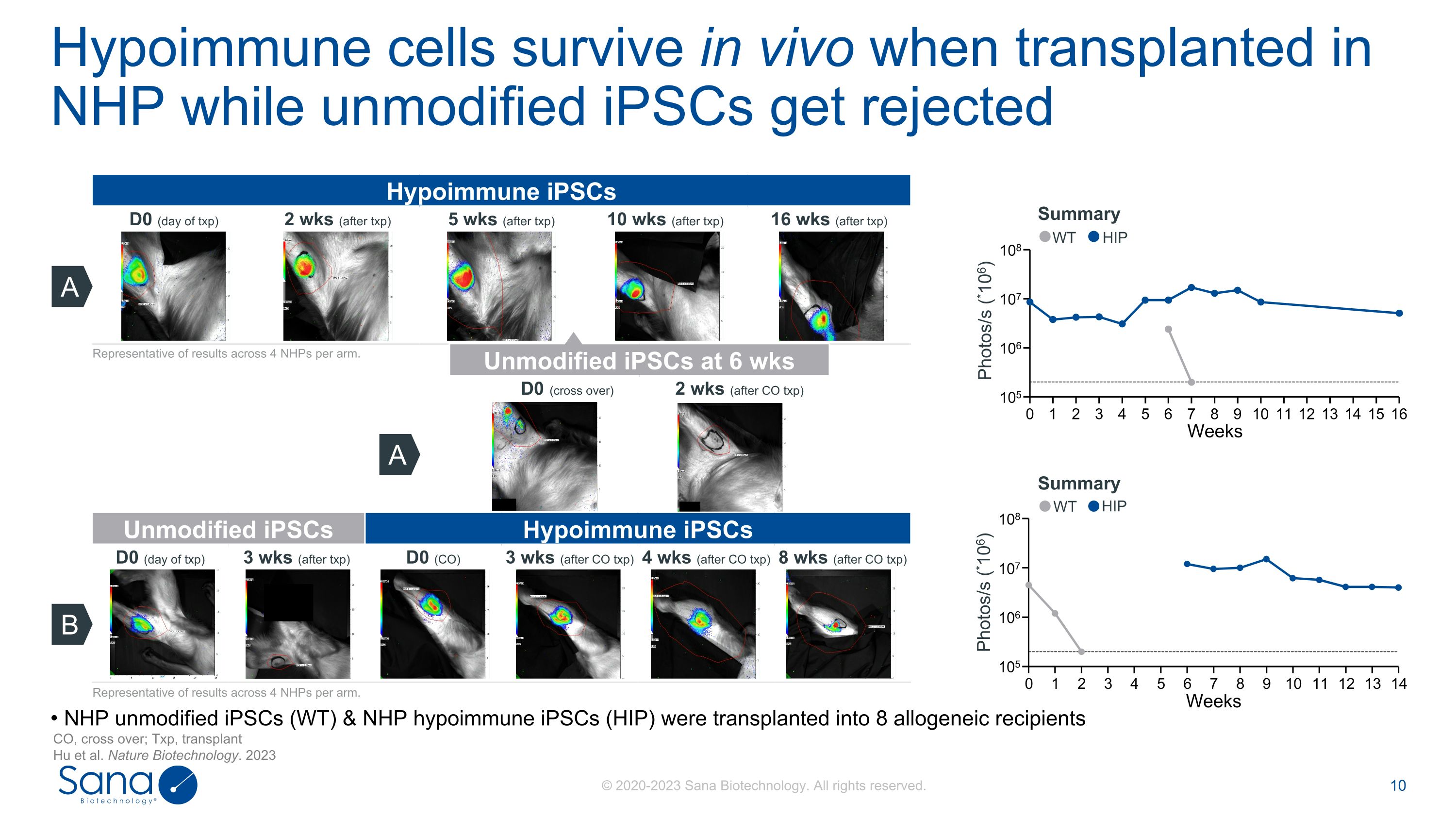
Hypoimmune cells survive in vivo when transplanted in NHP while unmodified iPSCs get rejected CO, cross over; Txp, transplant Hu et al. Nature Biotechnology. 2023 A Photos/s (*106) 0 1 2 3 4 5 6 7 8 9 10 11 12 13 14 105 106 107 108 Weeks Hypoimmune iPSCs D0 (day of txp) 2 wks (after txp) 5 wks (after txp) 10 wks (after txp) 16 wks (after txp) 0 1 2 3 4 5 6 7 8 9 10 11 12 13 14 15 16 105 106 107 108 Weeks Photos/s (*106) Summary A Unmodified iPSCs at 6 wks D0 (cross over) 2 wks (after CO txp) NHP unmodified iPSCs (WT) & NHP hypoimmune iPSCs (HIP) were transplanted into 8 allogeneic recipients Summary Representative of results across 4 NHPs per arm. Unmodified iPSCs Hypoimmune iPSCs D0 (day of txp) 3 wks (after txp) D0 (CO) 3 wks (after CO txp) 4 wks (after CO txp) 8 wks (after CO txp) B Representative of results across 4 NHPs per arm. WT WT HIP HIP
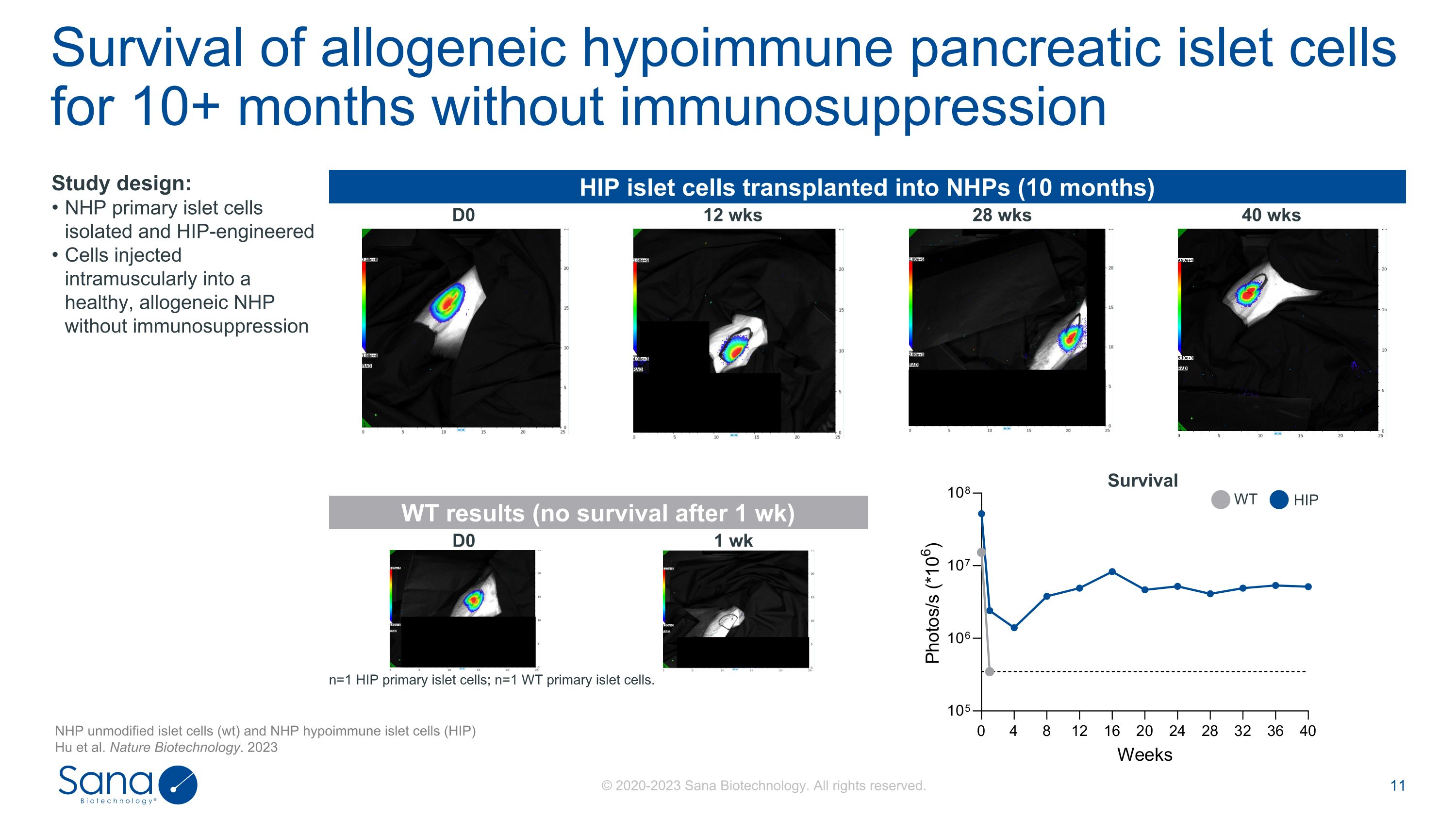
HIP islet cells transplanted into NHPs (10 months) D0 12 wks 28 wks 40 wks WT results (no survival after 1 wk) D0 1 wk n=1 HIP primary islet cells; n=1 WT primary islet cells. Survival of allogeneic hypoimmune pancreatic islet cells for 10+ months without immunosuppression Study design: NHP primary islet cells isolated and HIP-engineered Cells injected intramuscularly into a healthy, allogeneic NHP without immunosuppression Survival NHP unmodified islet cells (wt) and NHP hypoimmune islet cells (HIP) Hu et al. Nature Biotechnology. 2023 HIP WT
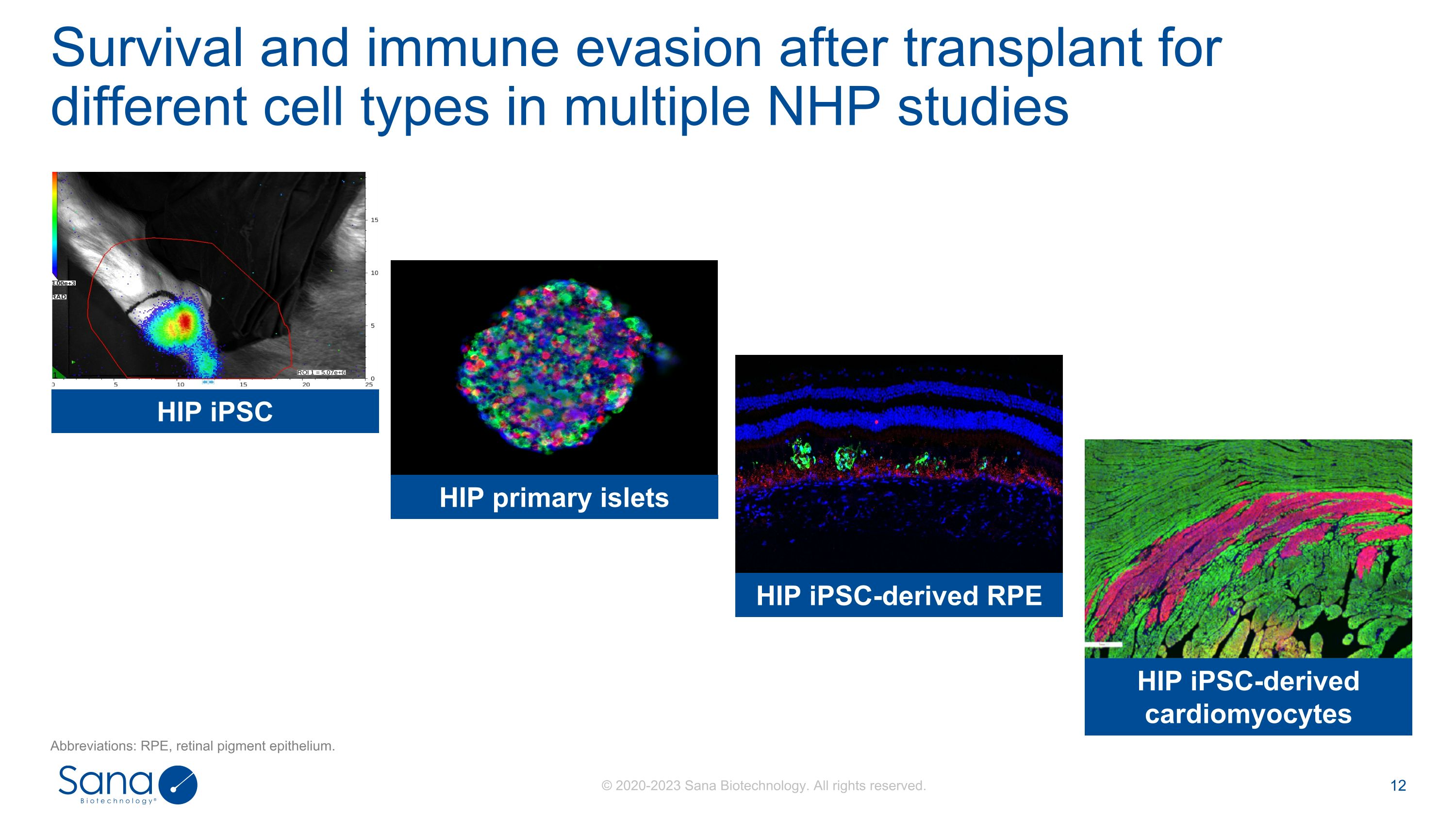
Survival and immune evasion after transplant for different cell types in multiple NHP studies Abbreviations: RPE, retinal pigment epithelium. HIP primary islets HIP iPSC-derived RPE HIP iPSC-derived cardiomyocytes HIP iPSC
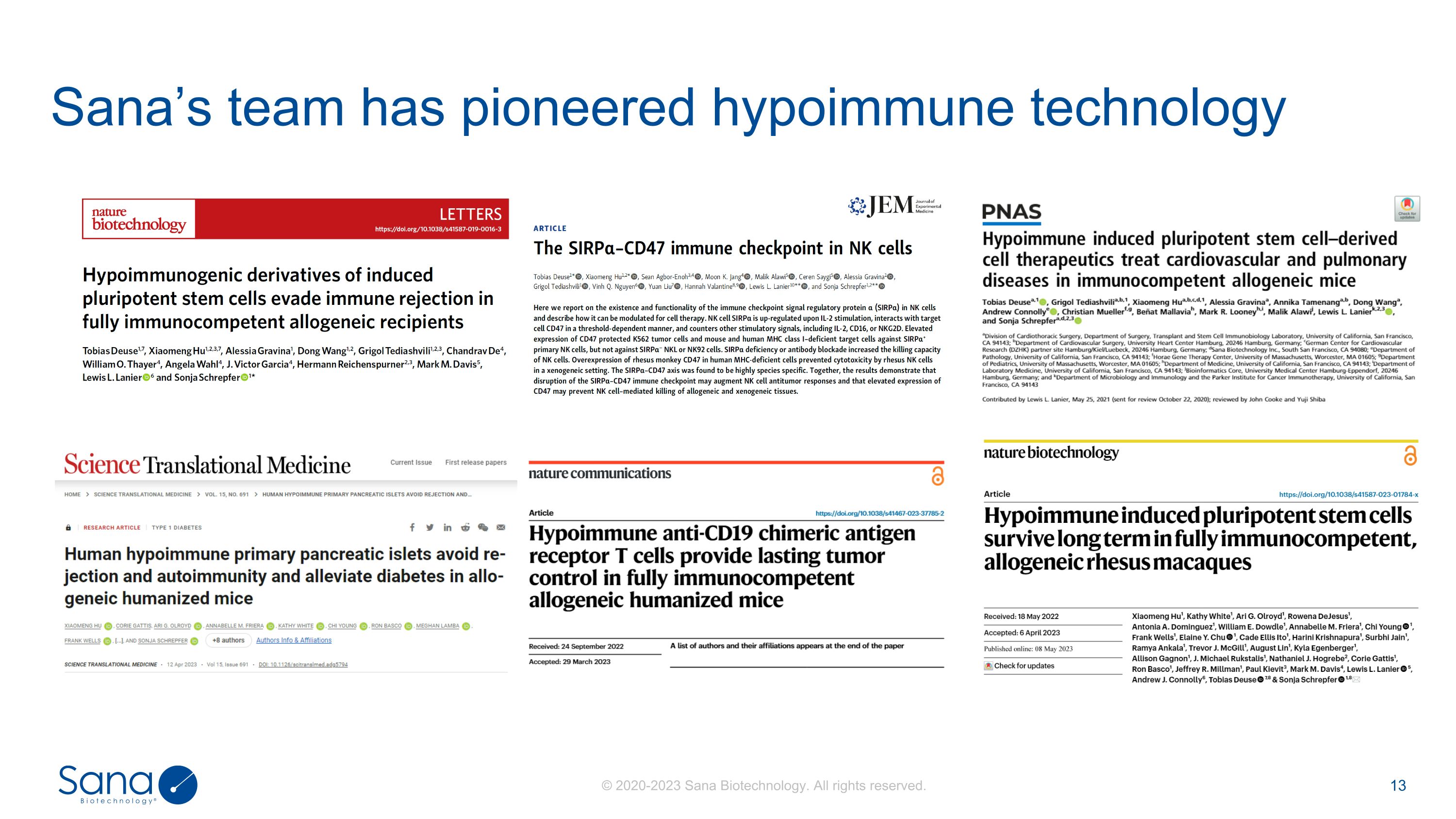
Sana’s team has pioneered hypoimmune technology
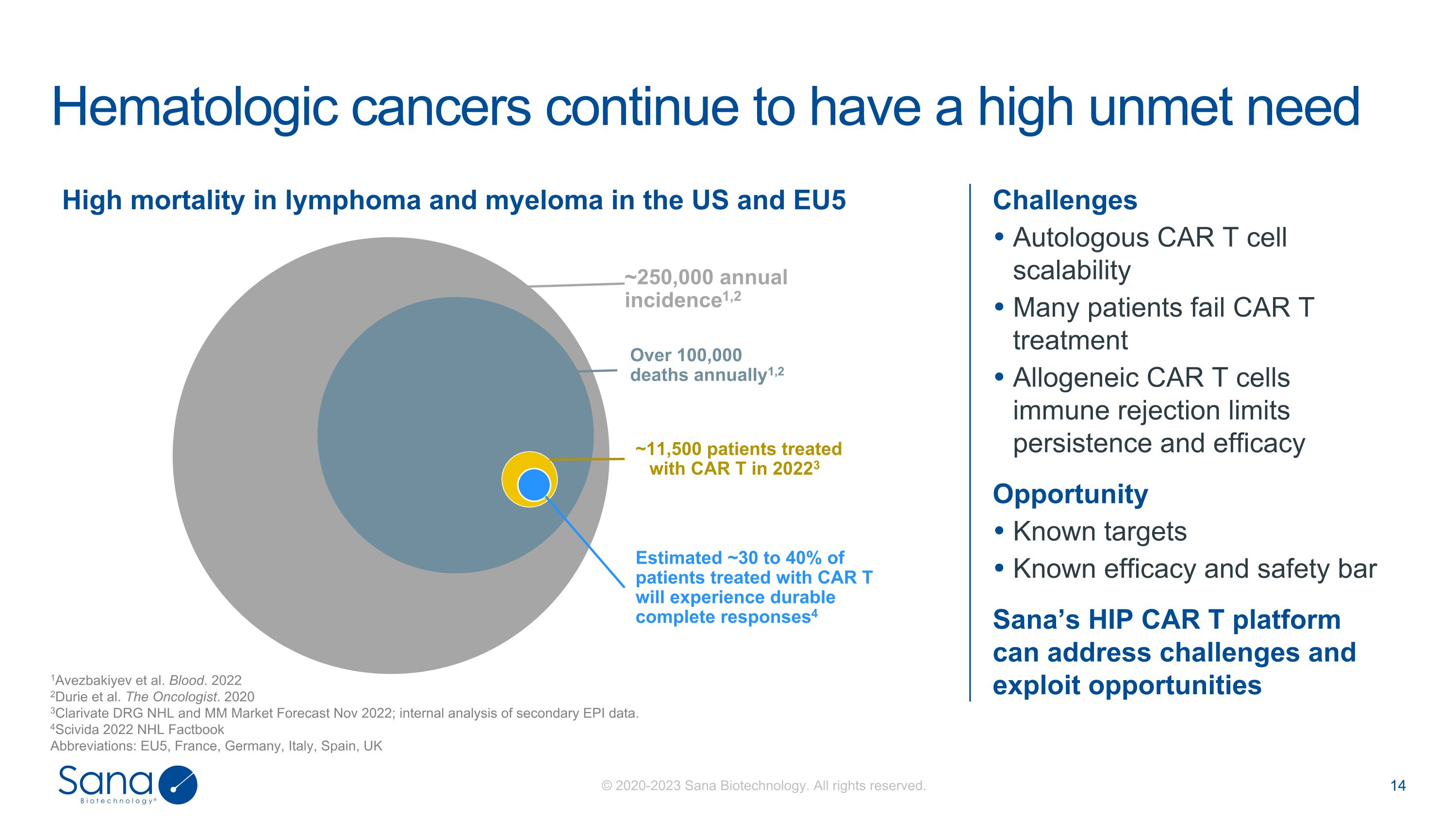
Challenges Autologous CAR T cell scalability Many patients fail CAR T treatment Allogeneic CAR T cells immune rejection limits persistence and efficacy Opportunity Known targets Known efficacy and safety bar Sana’s HIP CAR T platform can address challenges and exploit opportunities Hematologic cancers continue to have a high unmet need 1Avezbakiyev et al. Blood. 2022 2Durie et al. The Oncologist. 2020 3Clarivate DRG NHL and MM Market Forecast Nov 2022; internal analysis of secondary EPI data. 4Scivida 2022 NHL Factbook Abbreviations: EU5, France, Germany, Italy, Spain, UK High mortality in lymphoma and myeloma in the US and EU5 ~250,000 annual�incidence1,2 Over 100,000 deaths annually1,2 ~11,500 patients treated with CAR T in 20223 Estimated ~30 to 40% of patients treated with CAR T will experience durable complete responses4
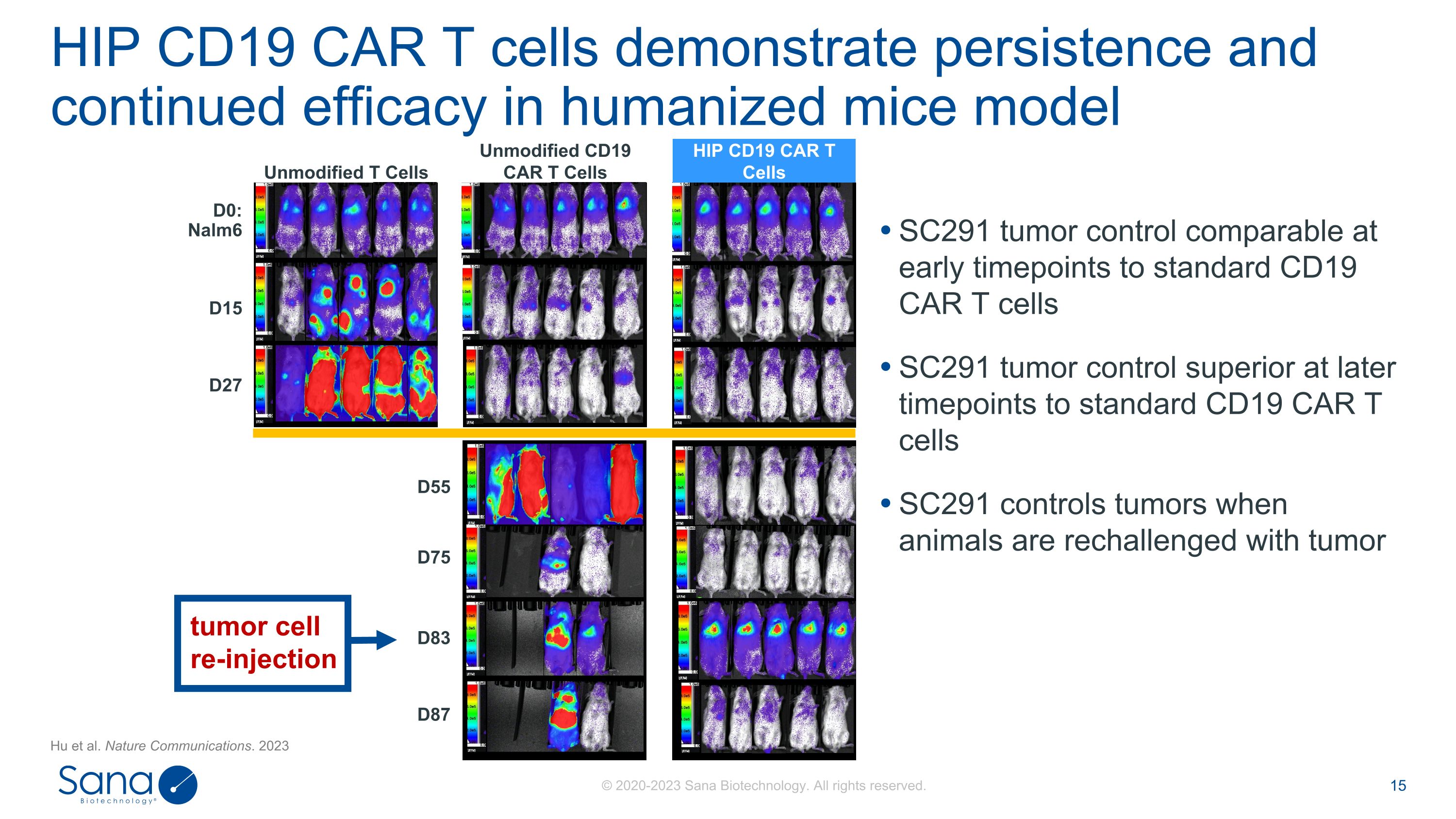
D55 D87 D75 D83 SC291 tumor control comparable at early timepoints to standard CD19 CAR T cells SC291 tumor control superior at later timepoints to standard CD19 CAR T cells SC291 controls tumors when animals are rechallenged with tumor HIP CD19 CAR T cells demonstrate persistence and continued efficacy in humanized mice model D0:�Nalm6 D15 D27 Unmodified CD19 CAR T Cells Unmodified T Cells HIP CD19 CAR T Cells tumor cell�re-injection Hu et al. Nature Communications. 2023
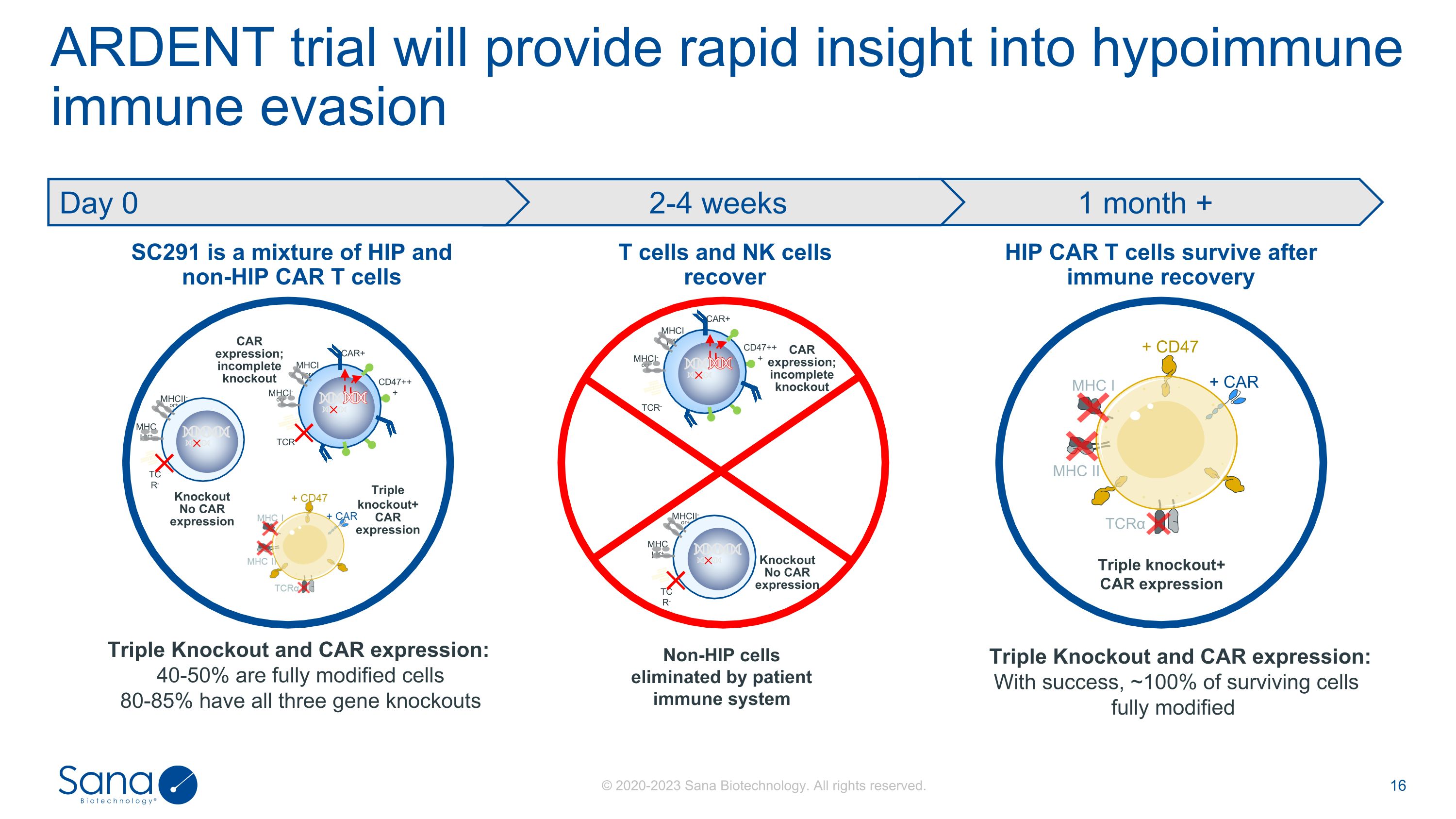
ARDENT trial will provide rapid insight into hypoimmune immune evasion SC291 is a mixture of HIP and non-HIP CAR T cells HIP CAR T cells survive after immune recovery T cells and NK cells recover Triple Knockout and CAR expression: 40-50% are fully modified cells 80-85% have all three gene knockouts Non-HIP cells eliminated by patient immune system Triple knockout+ CAR expression CAR expression; incomplete knockout MHCI-or+ TCR- CAR+ CD47+++ MHCII-or+ MHCI-or+ TCR- MHCII-or+ Knockout No CAR expression Triple knockout+ CAR expression MHC I MHC II TCRα + CAR + CD47 1 month + 2-4 weeks Day 0 CAR expression; incomplete knockout MHCI-or+ TCR- CAR+ CD47+++ MHCII-or+ MHCI-or+ TCR- MHCII-or+ Knockout No CAR expression Triple Knockout and CAR expression: With success, ~100% of surviving cells fully modified
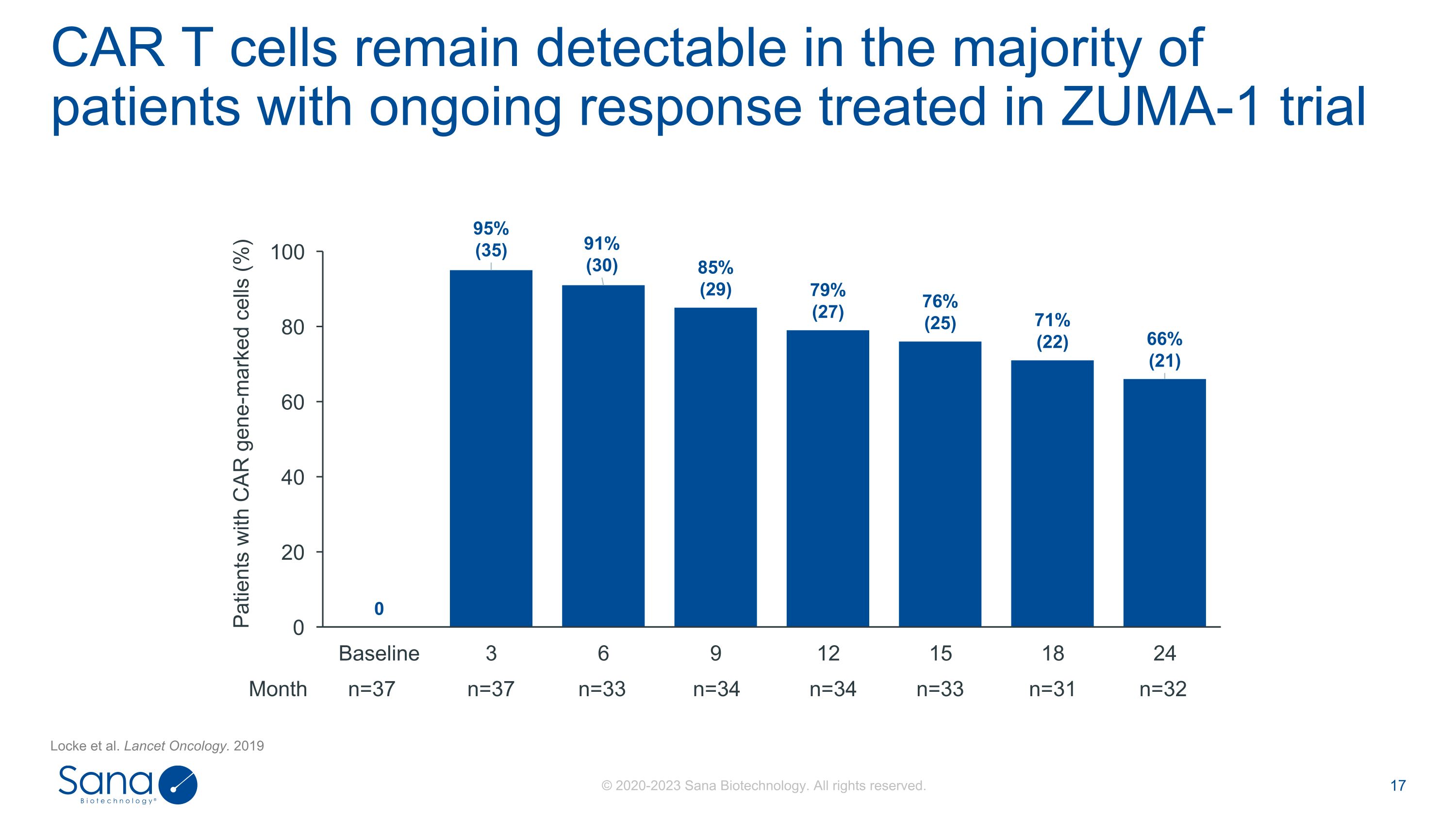
Locke et al. Lancet Oncology. 2019 CAR T cells remain detectable in the majority of patients with ongoing response treated in ZUMA-1 trial Patients with CAR gene-marked cells (%) Month n=37 n=37 n=33 n=34 n=34 n=33 n=31 n=32
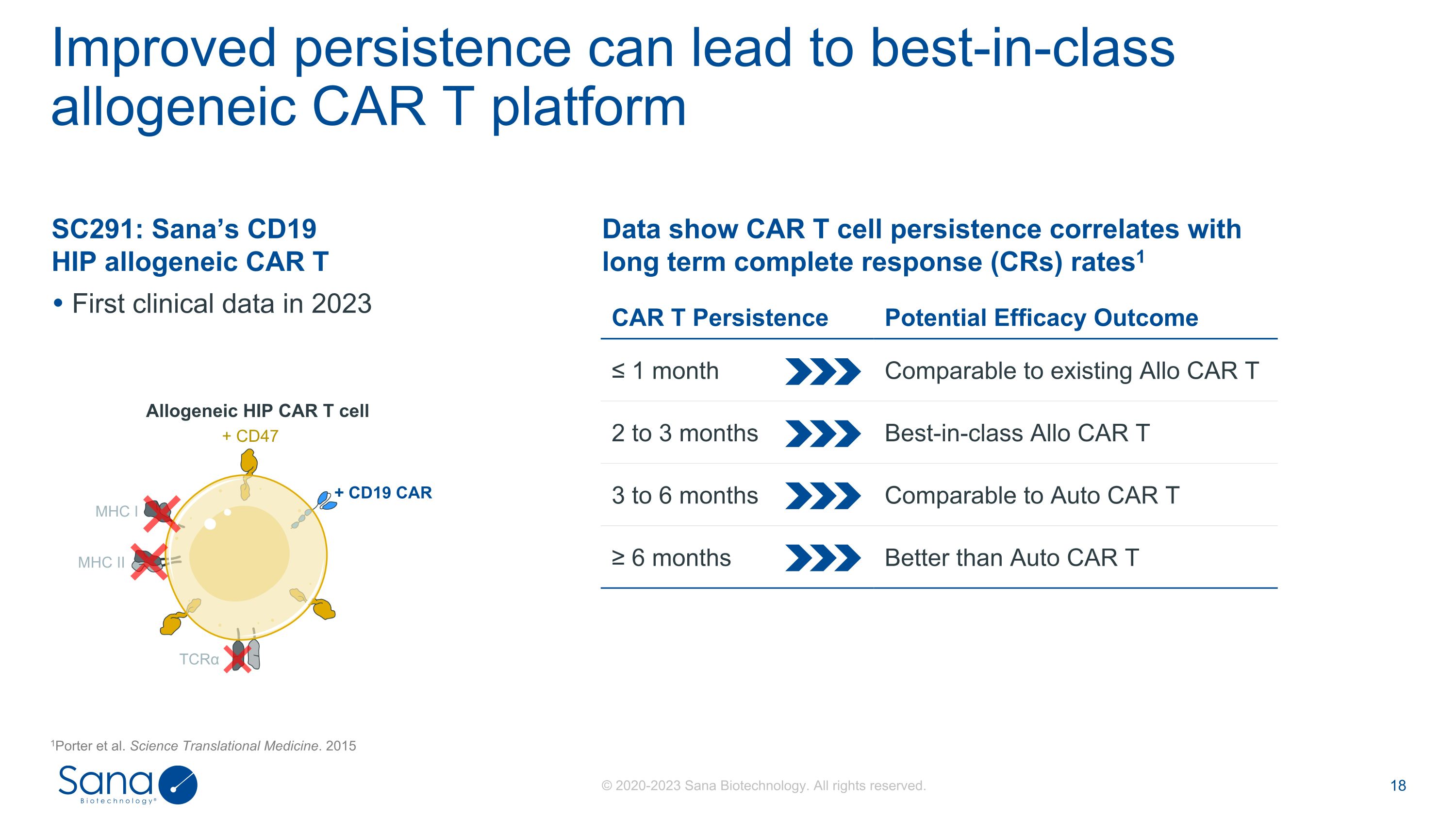
SC291: Sana’s CD19�HIP allogeneic CAR T First clinical data in 2023 Data show CAR T cell persistence correlates with long term complete response (CRs) rates1 Improved persistence can lead to best-in-class allogeneic CAR T platform CAR T Persistence Potential Efficacy Outcome ≤ 1 month Comparable to existing Allo CAR T 2 to 3 months Best-in-class Allo CAR T 3 to 6 months Comparable to Auto CAR T ≥ 6 months Better than Auto CAR T Allogeneic HIP CAR T cell MHC I MHC II TCRα + CD19 CAR + CD47 1Porter et al. Science Translational Medicine. 2015
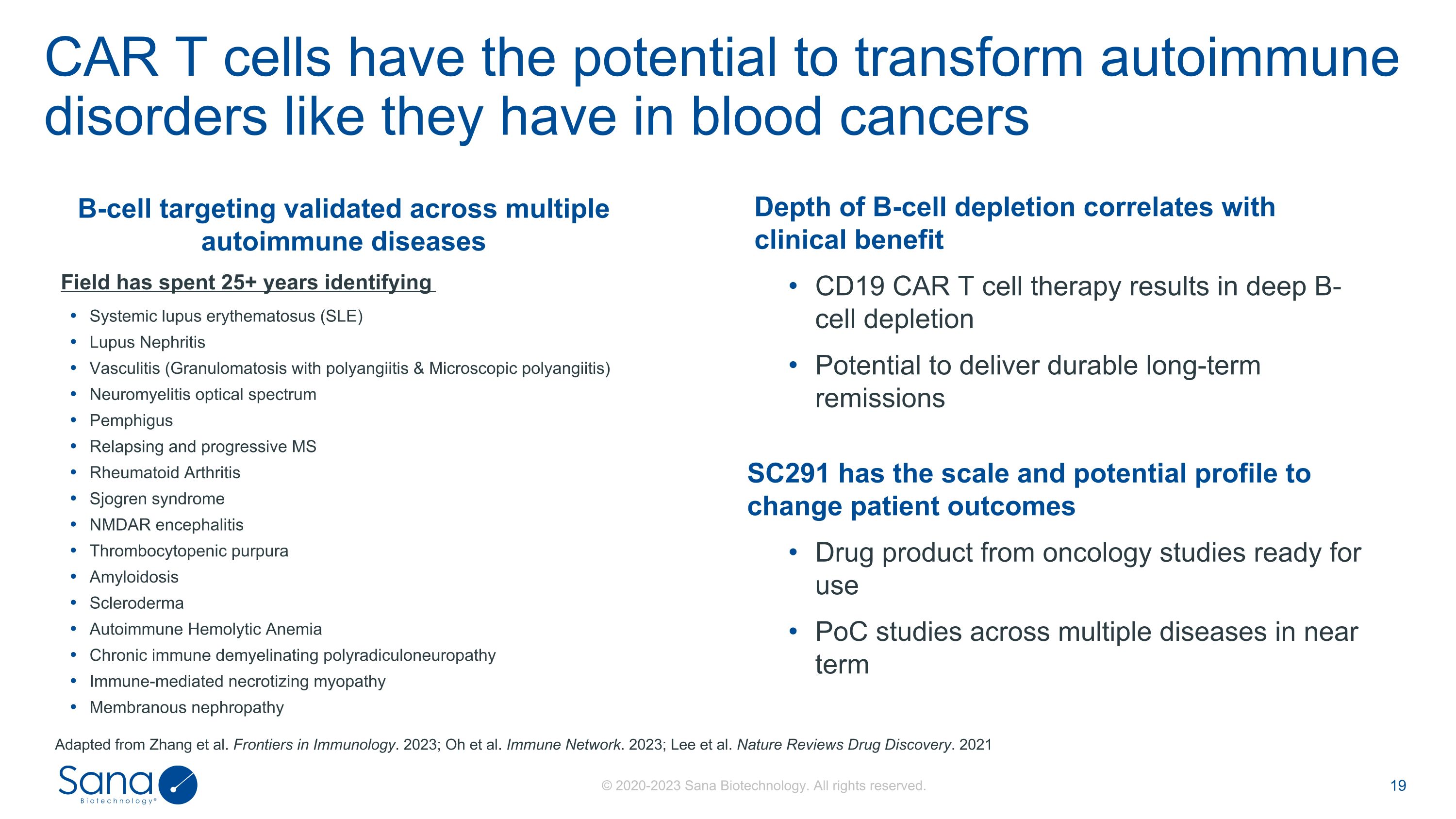
CAR T cells have the potential to transform autoimmune �disorders like they have in blood cancers Depth of B-cell depletion correlates with clinical benefit CD19 CAR T cell therapy results in deep B-cell depletion Potential to deliver durable long-term remissions SC291 has the scale and potential profile to change patient outcomes Drug product from oncology studies ready for use PoC studies across multiple diseases in near term B-cell targeting validated across multiple autoimmune diseases Adapted from Zhang et al. Frontiers in Immunology. 2023; Oh et al. Immune Network. 2023; Lee et al. Nature Reviews Drug Discovery. 2021 Field has spent 25+ years identifying Systemic lupus erythematosus (SLE) Lupus Nephritis Vasculitis (Granulomatosis with polyangiitis & Microscopic polyangiitis) Neuromyelitis optical spectrum Pemphigus Relapsing and progressive MS Rheumatoid Arthritis Sjogren syndrome NMDAR encephalitis Thrombocytopenic purpura Amyloidosis Scleroderma Autoimmune Hemolytic Anemia Chronic immune demyelinating polyradiculoneuropathy Immune-mediated necrotizing myopathy Membranous nephropathy
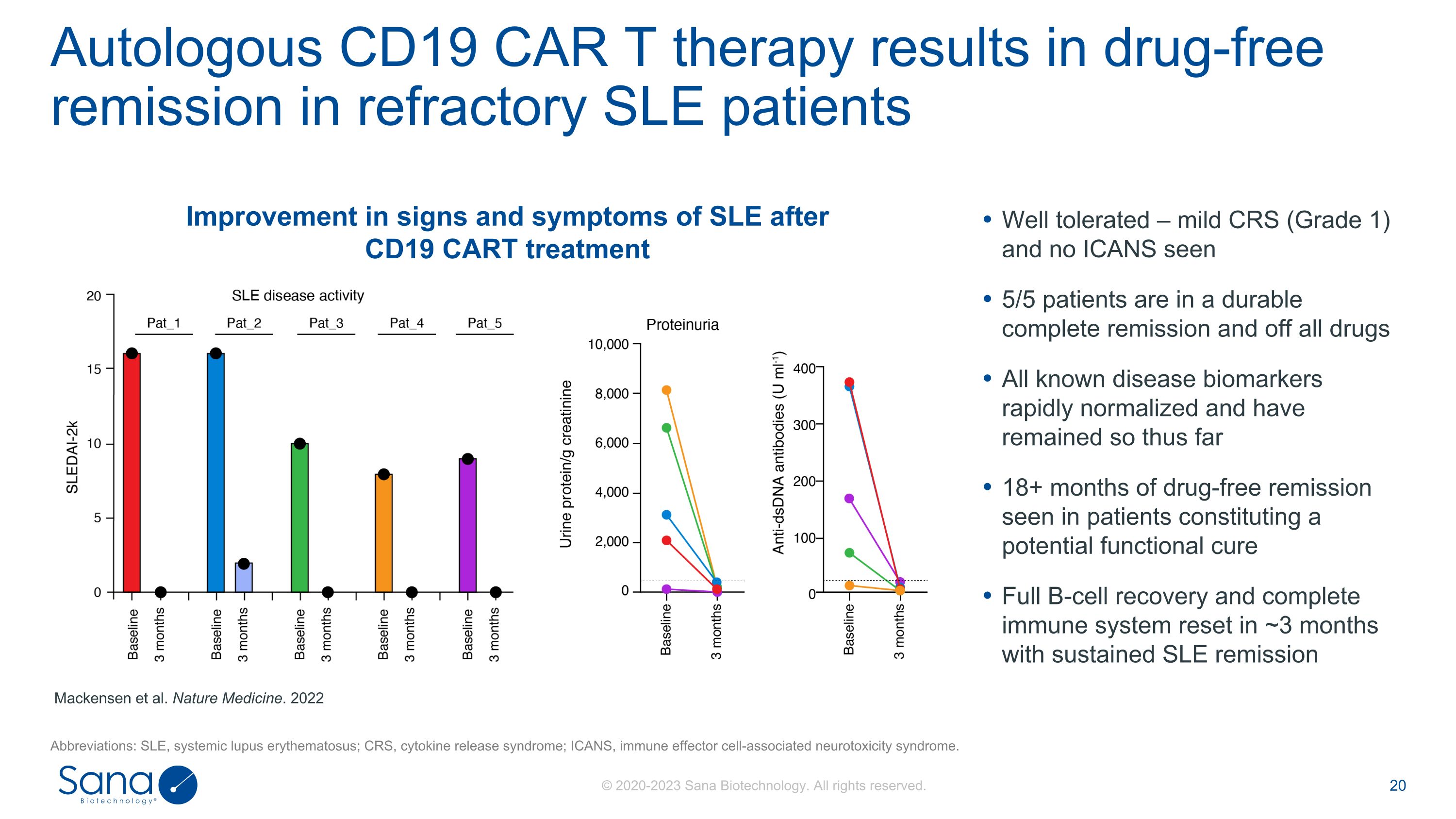
Autologous CD19 CAR T therapy results in drug-free remission in refractory SLE patients Abbreviations: SLE, systemic lupus erythematosus; CRS, cytokine release syndrome; ICANS, immune effector cell-associated neurotoxicity syndrome. Mackensen et al. Nature Medicine. 2022 Improvement in signs and symptoms of SLE after CD19 CART treatment Well tolerated – mild CRS (Grade 1) and no ICANS seen 5/5 patients are in a durable complete remission and off all drugs All known disease biomarkers rapidly normalized and have remained so thus far 18+ months of drug-free remission seen in patients constituting a potential functional cure Full B-cell recovery and complete immune system reset in ~3 months with sustained SLE remission
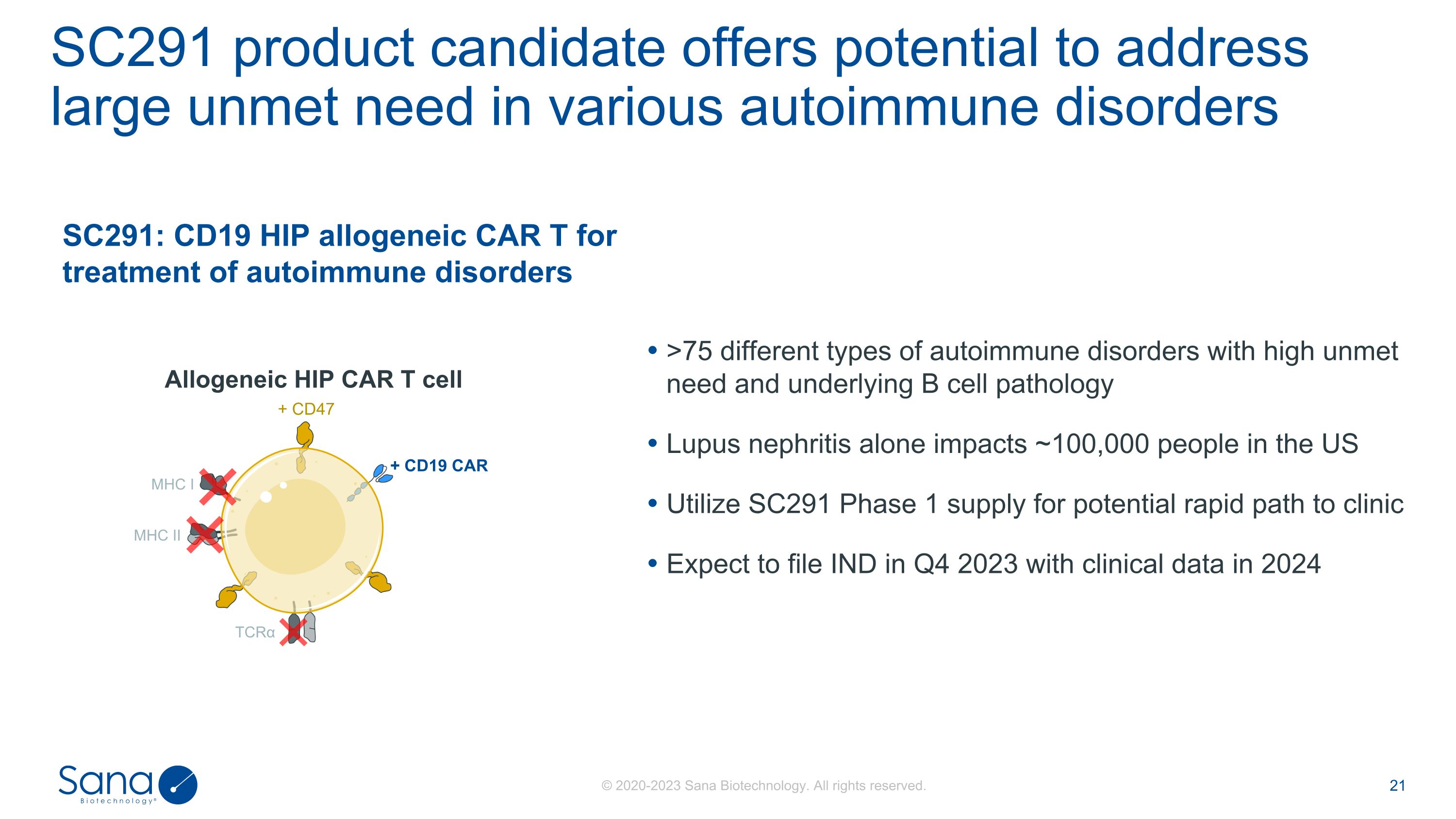
SC291 product candidate offers potential to address large unmet need in various autoimmune disorders SC291: CD19 HIP allogeneic CAR T for treatment of autoimmune disorders Allogeneic HIP CAR T cell MHC I MHC II TCRα + CD19 CAR + CD47 >75 different types of autoimmune disorders with high unmet need and underlying B cell pathology Lupus nephritis alone impacts ~100,000 people in the US Utilize SC291 Phase 1 supply for potential rapid path to clinic Expect to file IND in Q4 2023 with clinical data in 2024
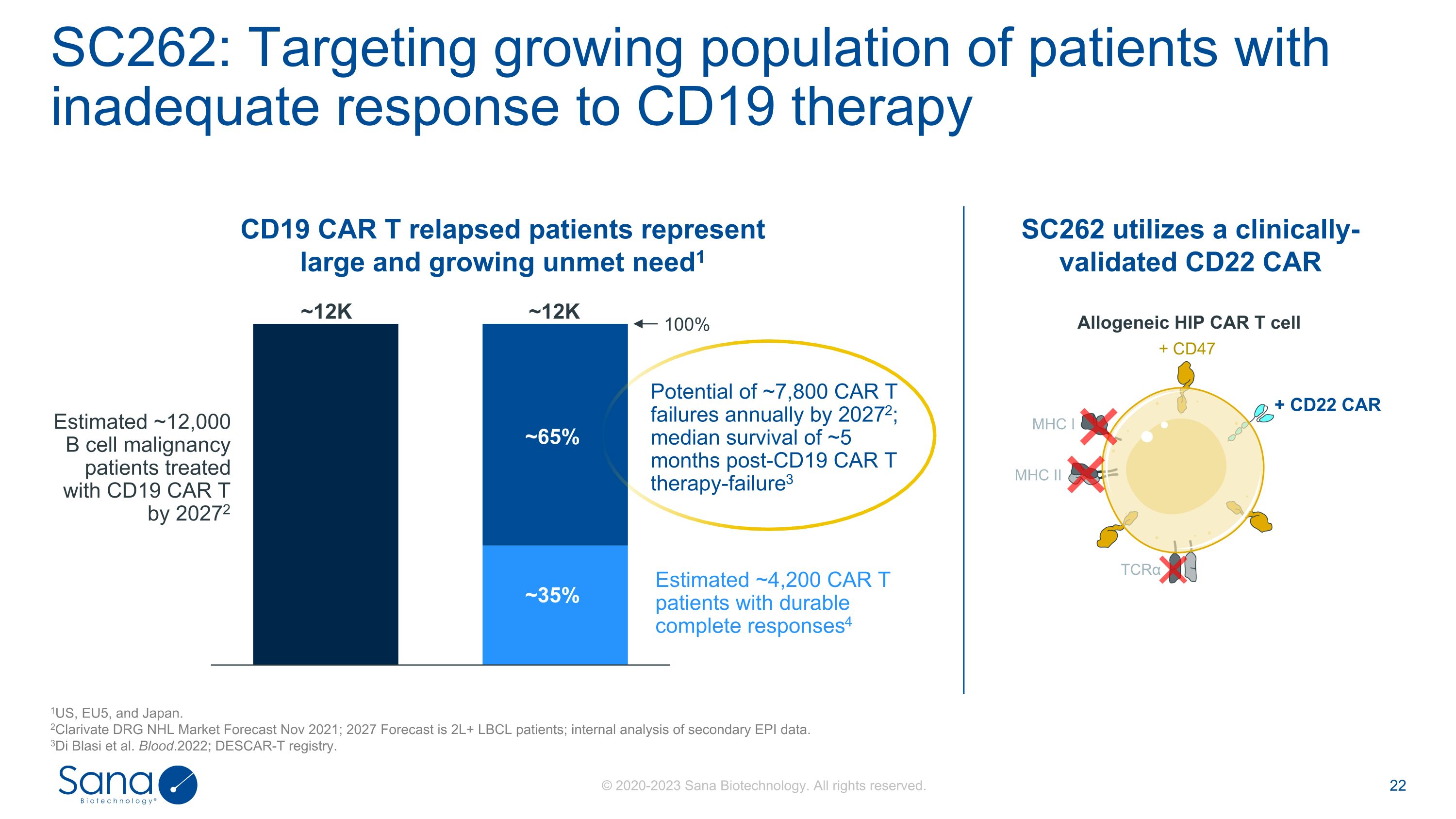
SC262: Targeting growing population of patients with inadequate response to CD19 therapy 1US, EU5, and Japan. 2Clarivate DRG NHL Market Forecast Nov 2021; 2027 Forecast is 2L+ LBCL patients; internal analysis of secondary EPI data. 3Di Blasi et al. Blood.2022; DESCAR-T registry. ~65% ~35% 100% ~12K ~12K Potential of ~7,800 CAR T failures annually by 20272; median survival of ~5 months post-CD19 CAR T therapy-failure3 Estimated ~12,000 B cell malignancy patients treated with CD19 CAR T by 20272 Estimated ~4,200 CAR T patients with durable complete responses4 Allogeneic HIP CAR T cell CD19 CAR T relapsed patients represent large and growing unmet need1 SC262 utilizes a clinically- validated CD22 CAR MHC I MHC II TCRα + CD47 + CD22 CAR
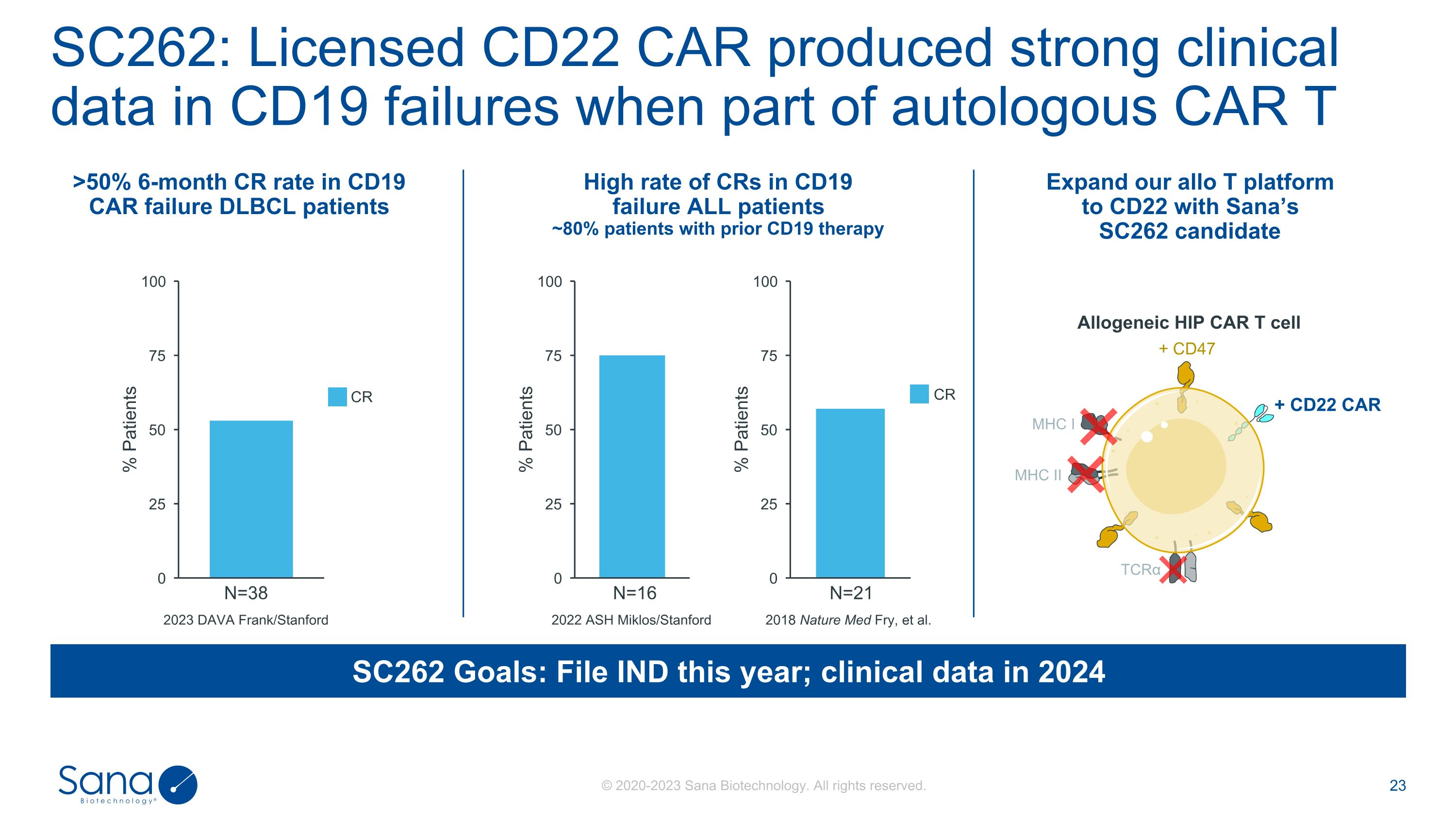
2023 DAVA Frank/Stanford SC262 Goals: File IND this year; clinical data in 2024 N=38 SC262: Licensed CD22 CAR produced strong clinical data in CD19 failures when part of autologous CAR T N=16 N=21 >50% 6-month CR rate in CD19�CAR failure DLBCL patients High rate of CRs in CD19�failure ALL patients ~80% patients with prior CD19 therapy 2022 ASH Miklos/Stanford 2018 Nature Med Fry, et al. Expand our allo T platform�to CD22 with Sana’s�SC262 candidate Allogeneic HIP CAR T cell MHC I MHC II + CD47 + CD22 CAR TCRα CR CR
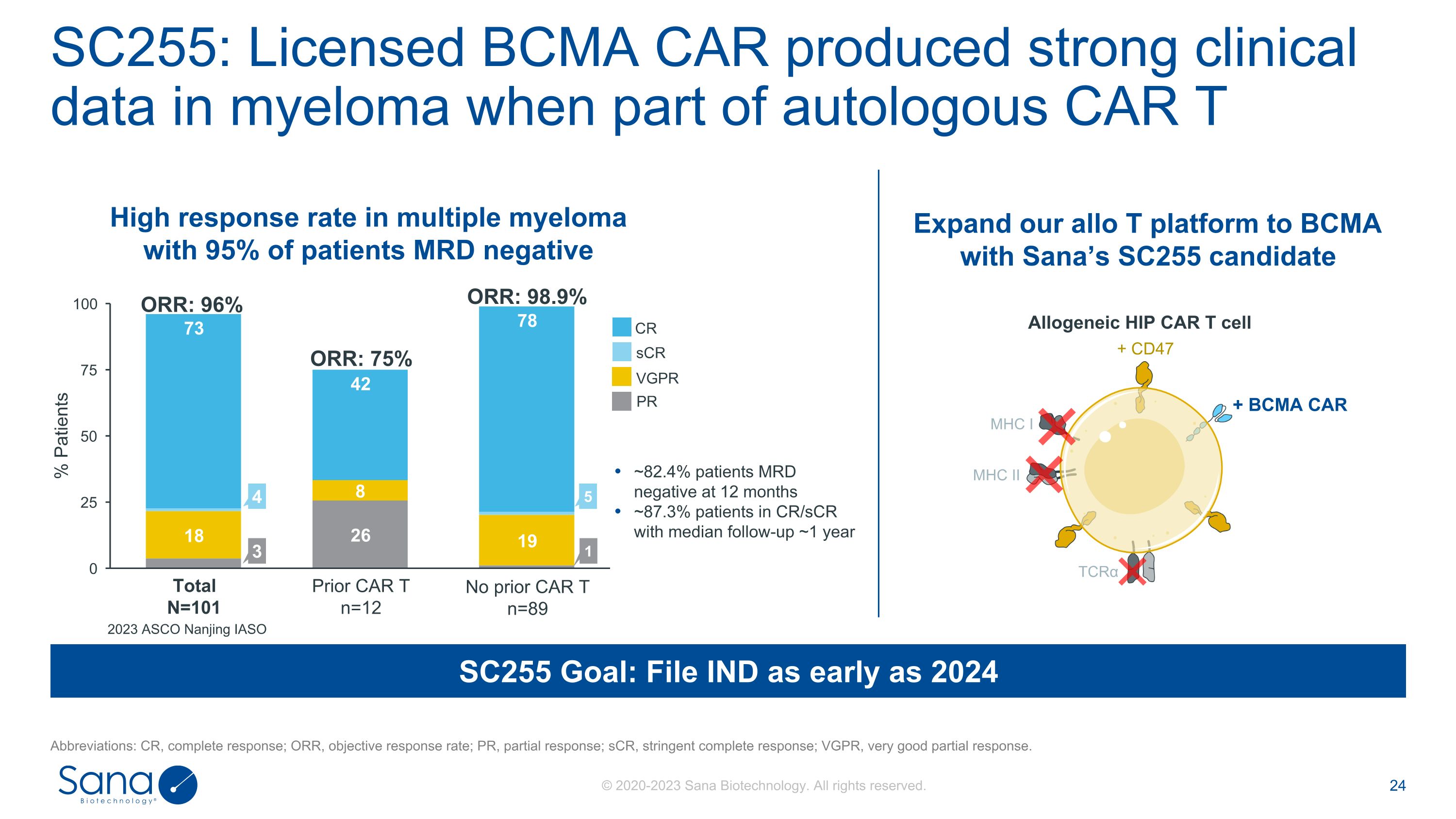
SC255: Licensed BCMA CAR produced strong clinical data in myeloma when part of autologous CAR T 4 3 ORR: 98.9% 5 ORR: 96% ORR: 75% Total N=101 SC255 Goal: File IND as early as 2024 Prior CAR T n=12 No prior CAR T n=89 1 ~82.4% patients MRD negative at 12 months ~87.3% patients in CR/sCR with median follow-up ~1 year 2023 ASCO Nanjing IASO Expand our allo T platform to BCMA with Sana’s SC255 candidate High response rate in multiple myeloma with 95% of patients MRD negative Allogeneic HIP CAR T cell Abbreviations: CR, complete response; ORR, objective response rate; PR, partial response; sCR, stringent complete response; VGPR, very good partial response. MHC I MHC II TCRα + BCMA CAR + CD47 CR sCR VGPR PR
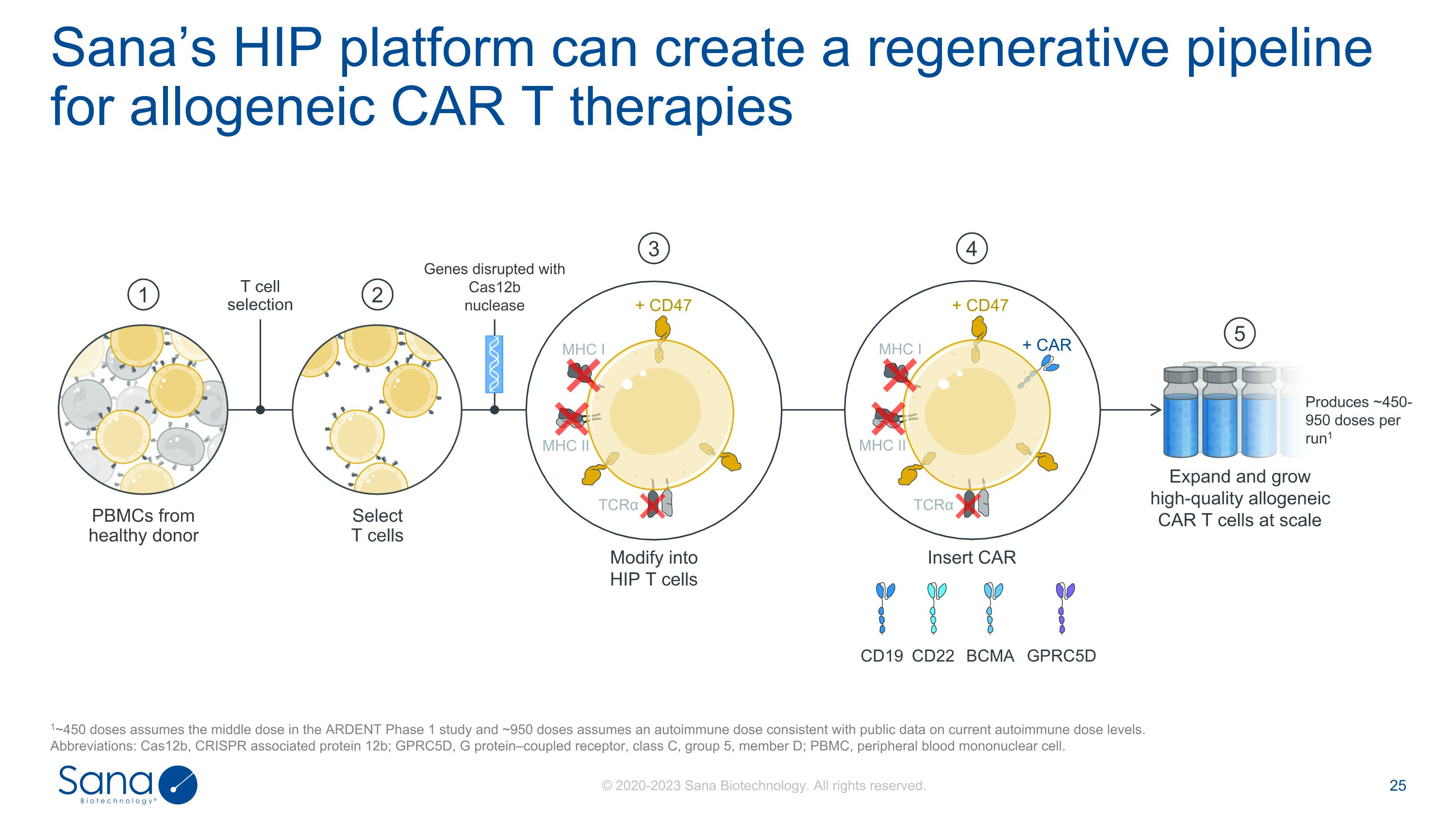
Sana’s HIP platform can create a regenerative pipeline for allogeneic CAR T therapies 1~450 doses assumes the middle dose in the ARDENT Phase 1 study and ~950 doses assumes an autoimmune dose consistent with public data on current autoimmune dose levels. Abbreviations: Cas12b, CRISPR associated protein 12b; GPRC5D, G protein–coupled receptor, class C, group 5, member D; PBMC, peripheral blood mononuclear cell. PBMCs from�healthy donor 1 2 Select�T cells T cell�selection Expand and grow�high-quality allogeneic CAR T cells at scale 5 Modify into�HIP T cells 3 Genes disrupted with Cas12b�nuclease Insert CAR 4 CD22 CD19 BCMA GPRC5D Produces ~450-950 doses per run1 + CD47 MHC I MHC II TCRα MHC I MHC II TCRα + CAR + CD47
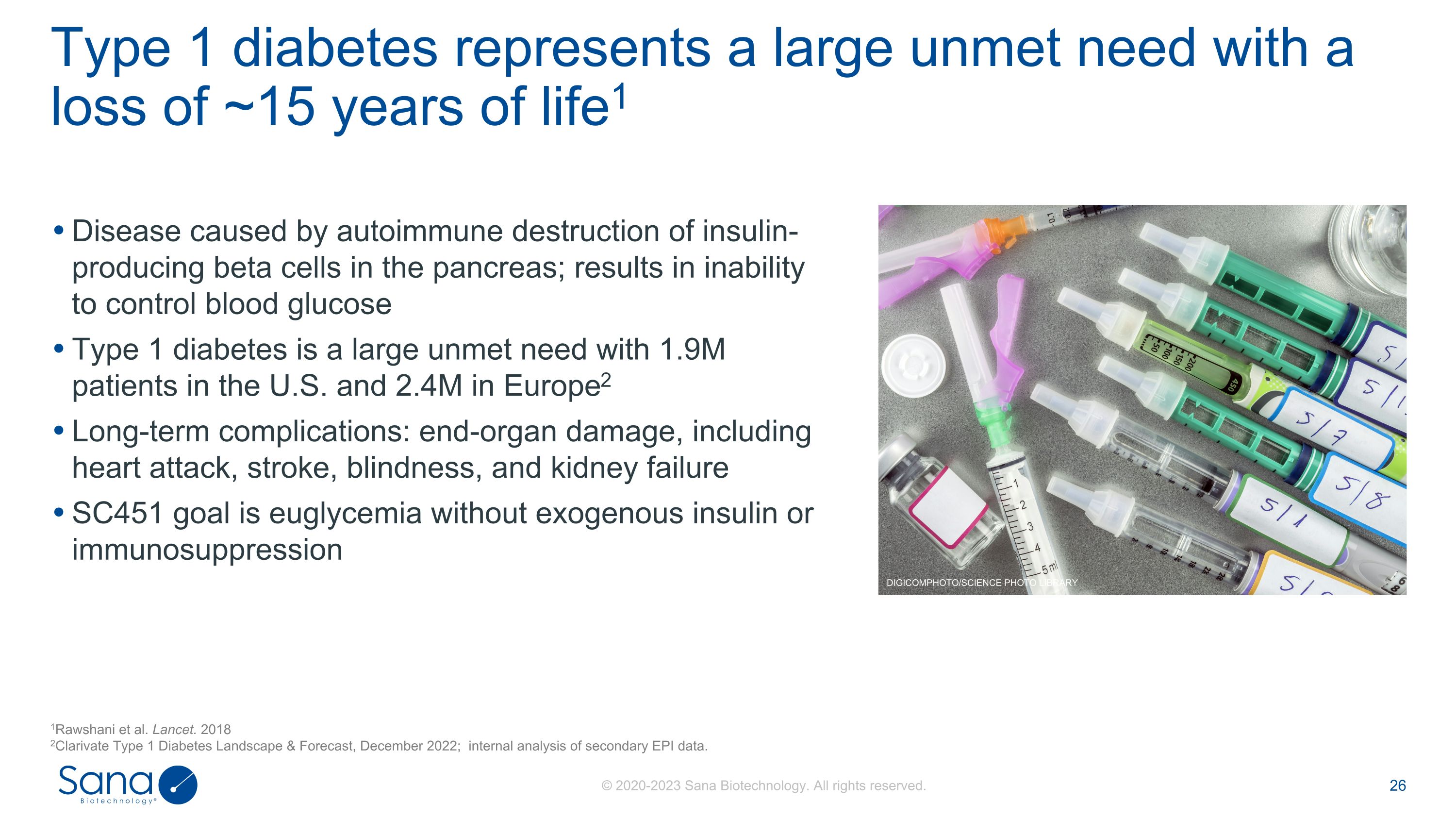
Disease caused by autoimmune destruction of insulin-producing beta cells in the pancreas; results in inability to control blood glucose Type 1 diabetes is a large unmet need with 1.9M patients in the U.S. and 2.4M in Europe2 Long-term complications: end-organ damage, including heart attack, stroke, blindness, and kidney failure SC451 goal is euglycemia without exogenous insulin or immunosuppression Type 1 diabetes represents a large unmet need with a loss of ~15 years of life1 1Rawshani et al. Lancet. 2018 2Clarivate Type 1 Diabetes Landscape & Forecast, December 2022; internal analysis of secondary EPI data. DIGICOMPHOTO/SCIENCE PHOTO LIBRARY
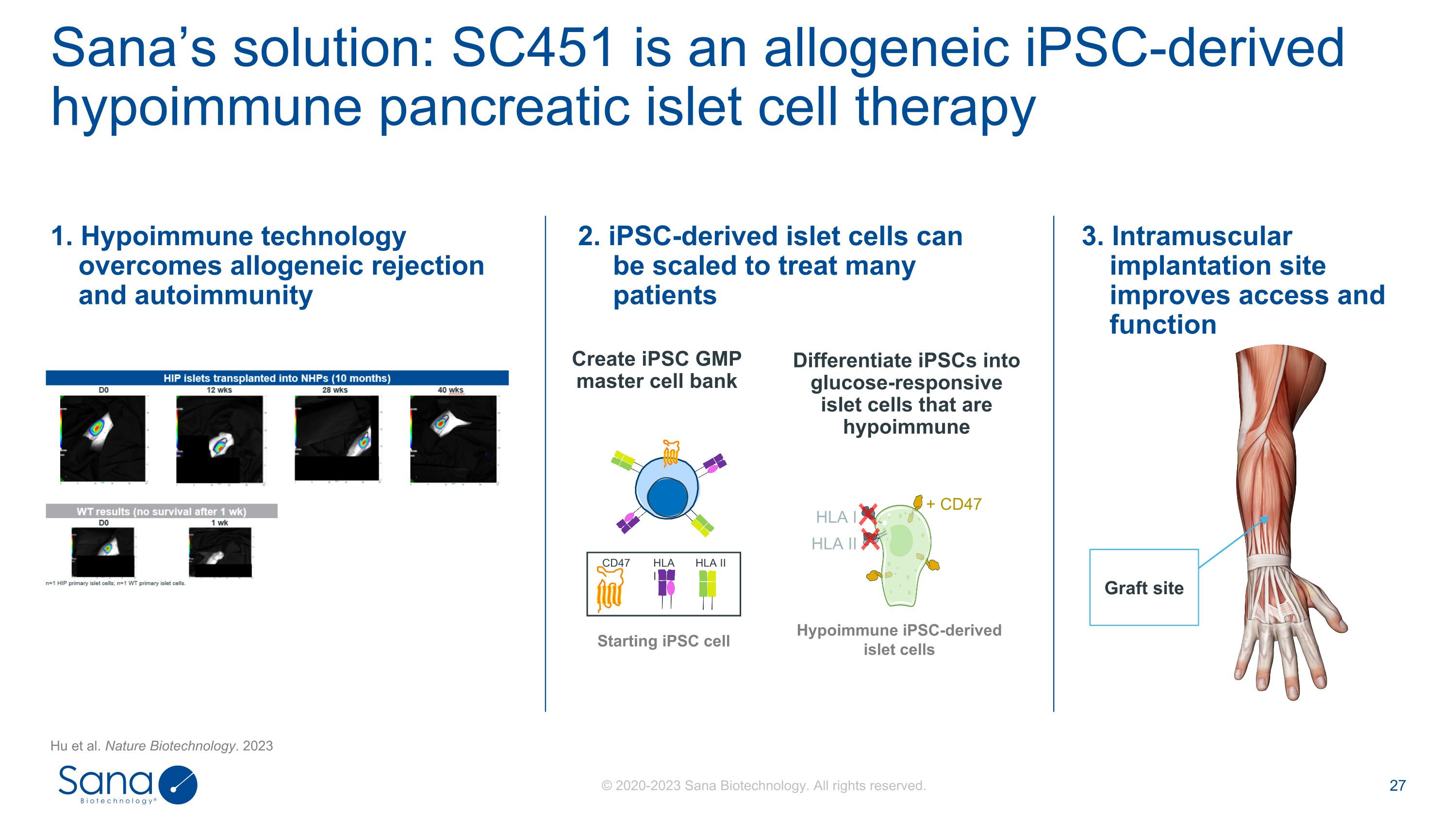
Sana’s solution: SC451 is an allogeneic iPSC-derived hypoimmune pancreatic islet cell therapy Hu et al. Nature Biotechnology. 2023 Differentiate iPSCs into glucose-responsive islet cells that are hypoimmune + CD47 HLA I HLA II Hypoimmune iPSC-derived islet cells Create iPSC GMP master cell bank Starting iPSC cell CD47 HLA I HLA II 1. Hypoimmune technology overcomes allogeneic rejection and autoimmunity 3. Intramuscular implantation site improves access and function 2. iPSC-derived islet cells can be scaled to treat many patients Graft site
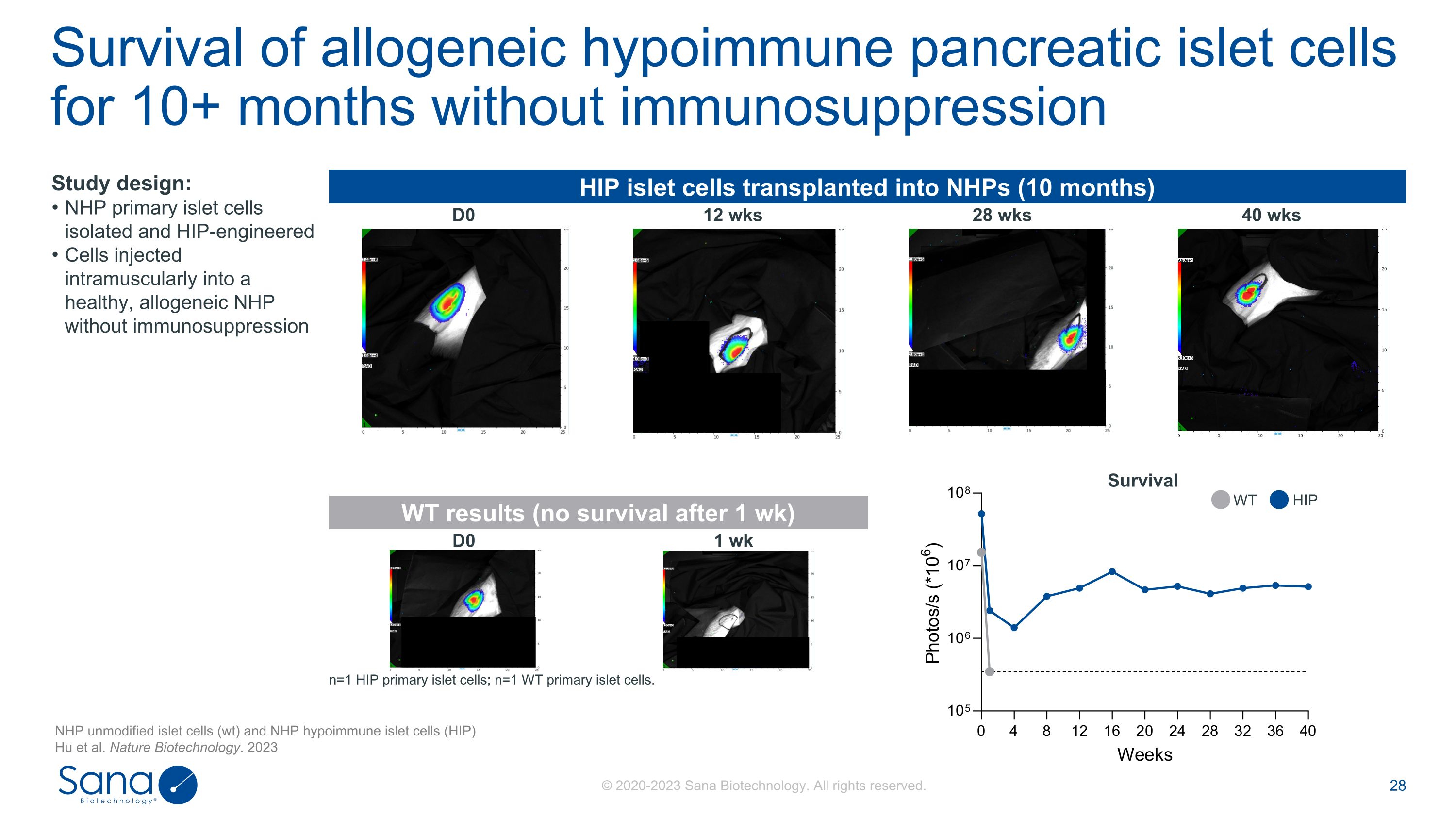
HIP islet cells transplanted into NHPs (10 months) D0 12 wks 28 wks 40 wks WT results (no survival after 1 wk) D0 1 wk n=1 HIP primary islet cells; n=1 WT primary islet cells. Survival of allogeneic hypoimmune pancreatic islet cells for 10+ months without immunosuppression Study design: NHP primary islet cells isolated and HIP-engineered Cells injected intramuscularly into a healthy, allogeneic NHP without immunosuppression Survival NHP unmodified islet cells (wt) and NHP hypoimmune islet cells (HIP) Hu et al. Nature Biotechnology. 2023 WT HIP
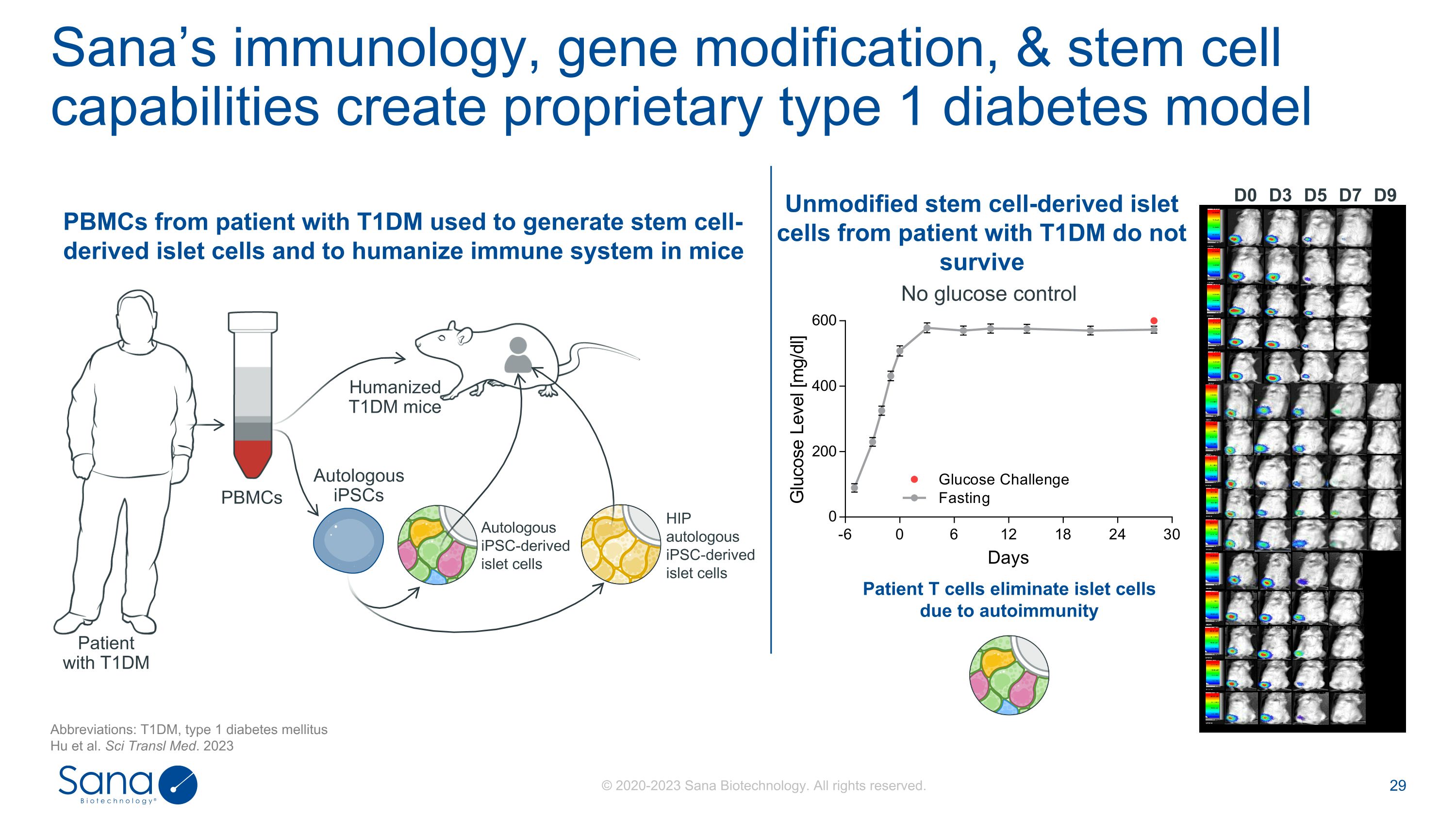
D0 D3 D7 D5 D9 No glucose control Patient T cells eliminate islet cells�due to autoimmunity Sana’s immunology, gene modification, & stem cell capabilities create proprietary type 1 diabetes model Abbreviations: T1DM, type 1 diabetes mellitus Hu et al. Sci Transl Med. 2023 Patient�with T1DM PBMCs Autologous iPSC-derived islet cells Humanized�T1DM mice Autologous iPSCs HIP autologous iPSC-derived islet cells Unmodified stem cell-derived islet cells from patient with T1DM do not survive PBMCs from patient with T1DM used to generate stem cell-derived islet cells and to humanize immune system in mice
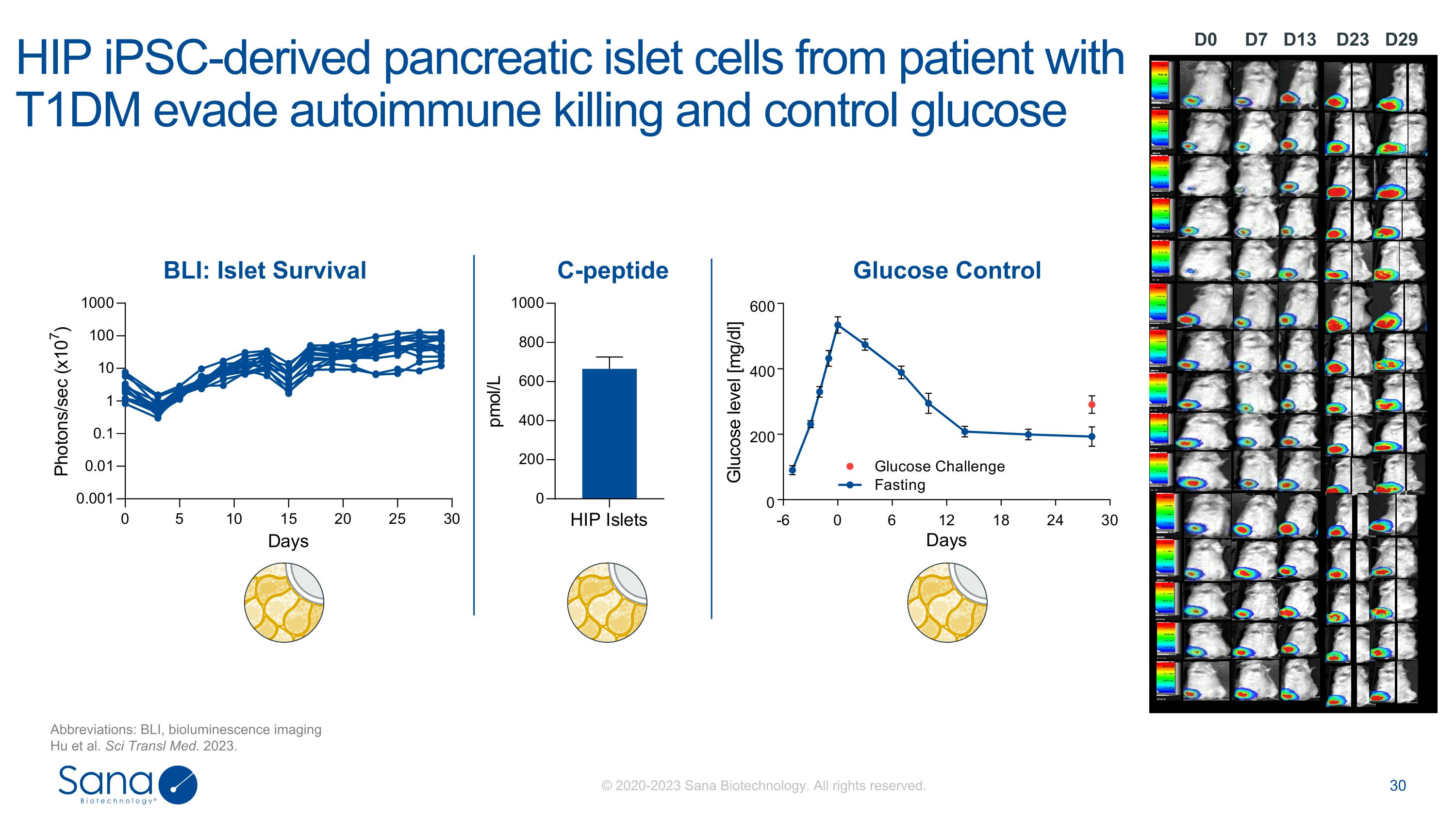
D7 D0 D23 D29 D13 HIP iPSC-derived pancreatic islet cells from patient with T1DM evade autoimmune killing and control glucose Abbreviations: BLI, bioluminescence imaging Hu et al. Sci Transl Med. 2023. BLI: Islet Survival C-peptide Glucose Control
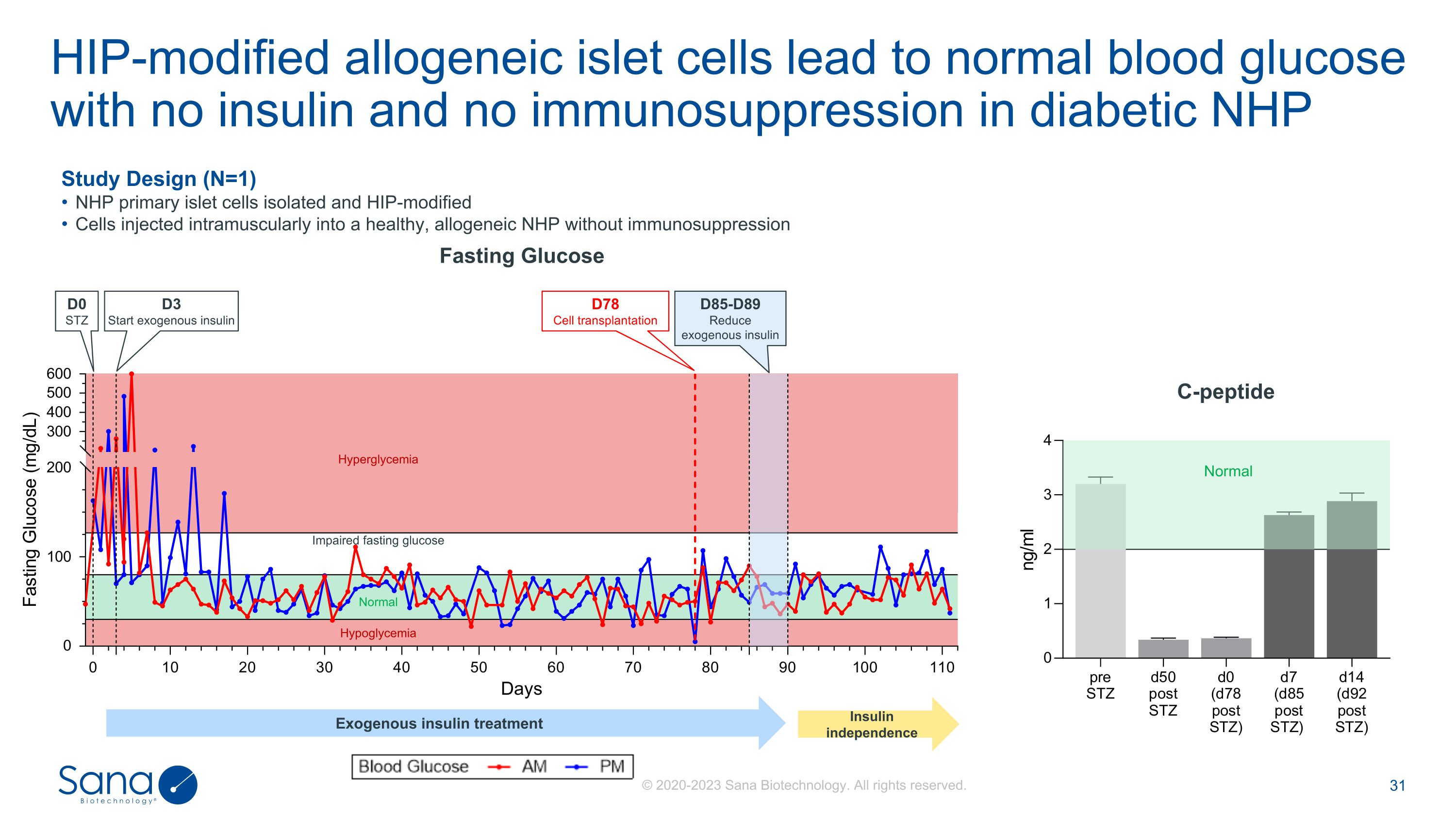
HIP-modified allogeneic islet cells lead to normal blood glucose with no insulin and no immunosuppression in diabetic NHP Normal Hypoglycemia Impaired fasting glucose Hyperglycemia D78 Cell transplantation D85-D89 Reduce exogenous insulin D0 STZ D3 Start exogenous insulin Study Design (N=1) NHP primary islet cells isolated and HIP-modified Cells injected intramuscularly into a healthy, allogeneic NHP without immunosuppression C-peptide Fasting Glucose Normal Exogenous insulin treatment Insulin independence © 2020-2023 Sana Biotechnology. All rights reserved.
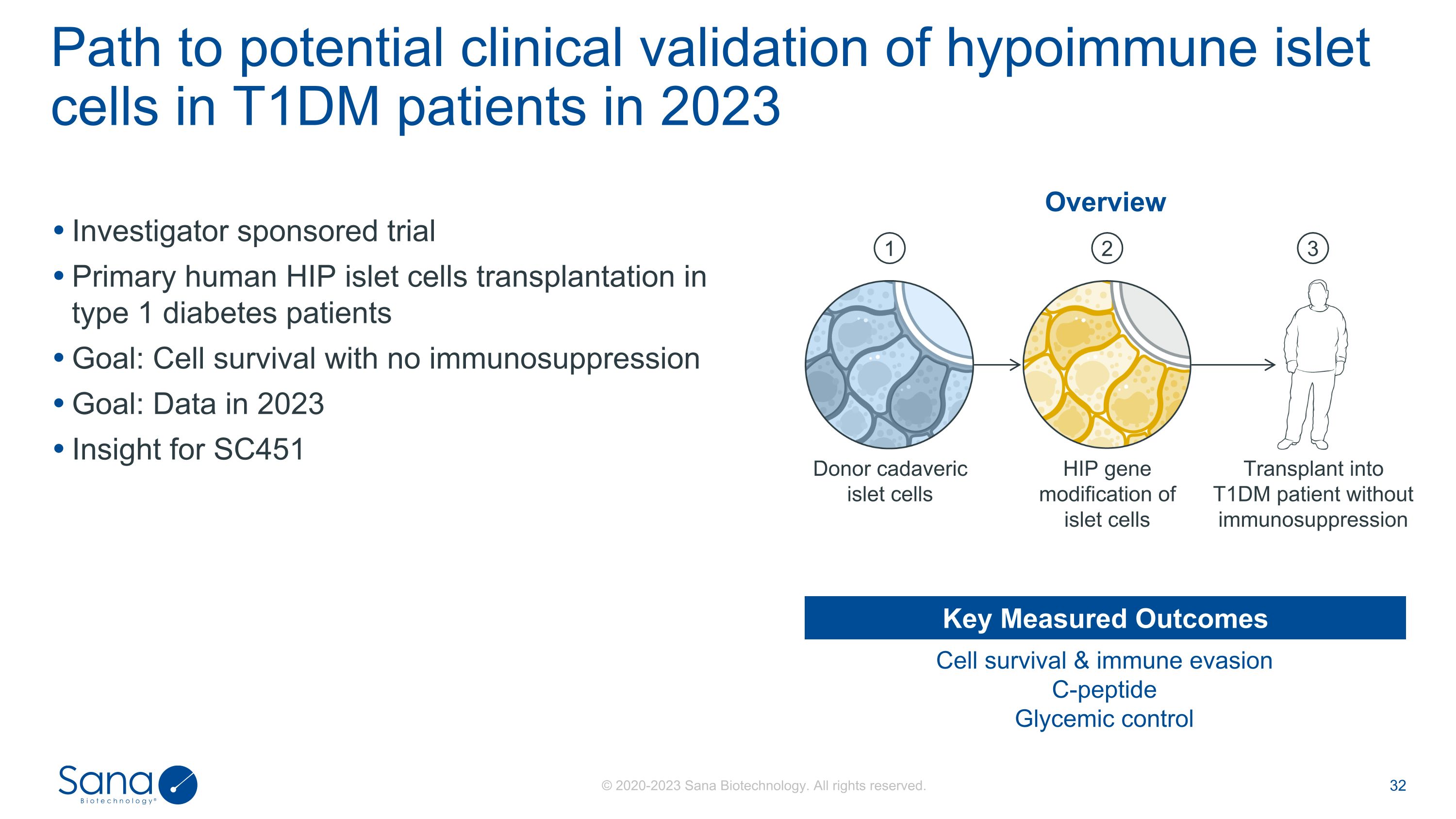
Investigator sponsored trial Primary human HIP islet cells transplantation in type 1 diabetes patients Goal: Cell survival with no immunosuppression Goal: Data in 2023 Insight for SC451 Path to potential clinical validation of hypoimmune islet cells in T1DM patients in 2023 Cell survival & immune evasion C-peptide Glycemic control Key Measured Outcomes Overview Transplant into�T1DM patient without immunosuppression HIP gene�modification of�islet cells Donor cadaveric�islet cells 1 2 3
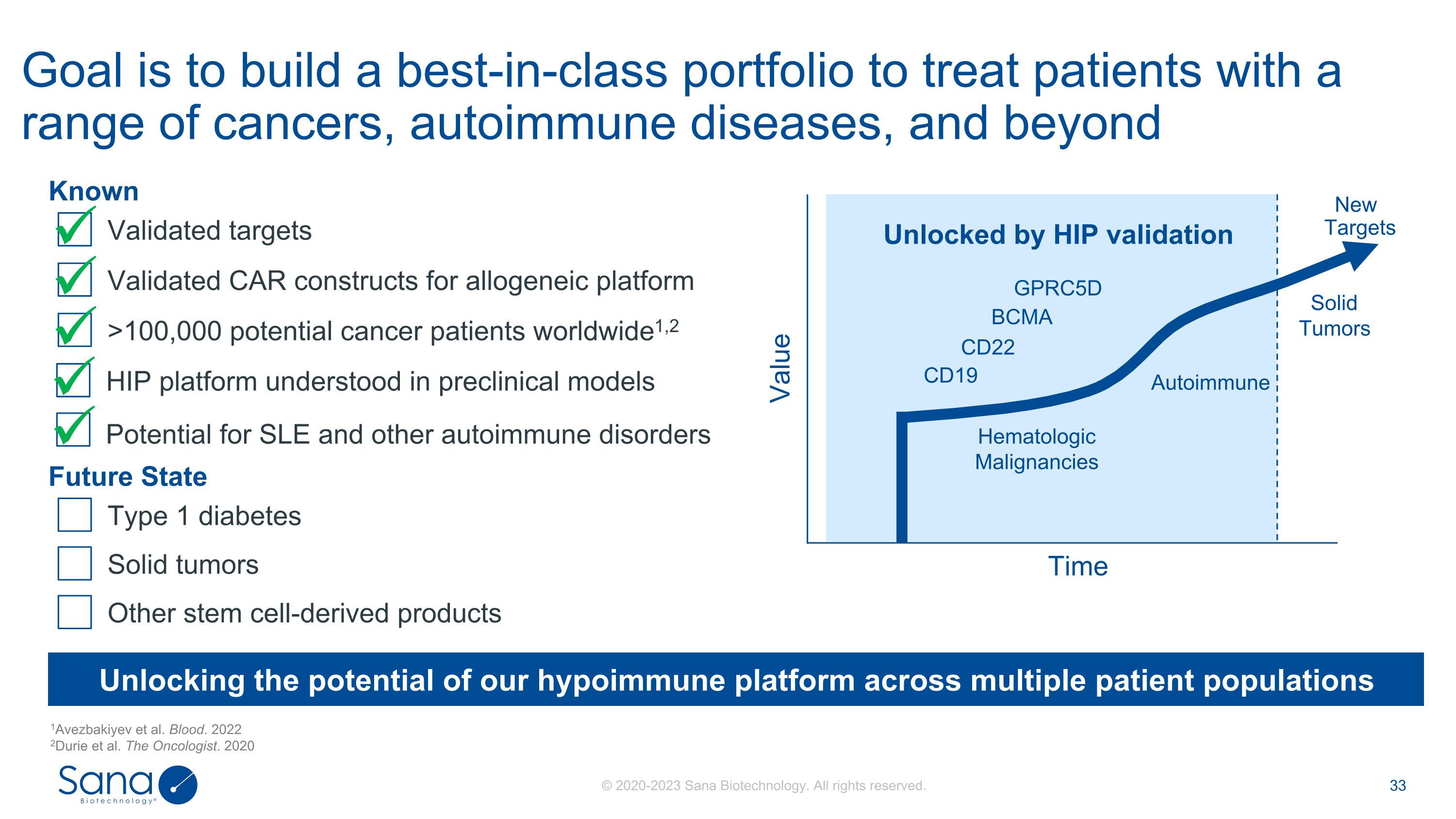
Goal is to build a best-in-class portfolio to treat patients with a range of cancers, autoimmune diseases, and beyond 1Avezbakiyev et al. Blood. 2022 2Durie et al. The Oncologist. 2020 Unlocking the potential of our hypoimmune platform across multiple patient populations Value Time CD19 CD22 BCMA Autoimmune Unlocked by HIP validation Solid�Tumors New Targets Hematologic�Malignancies GPRC5D Known >100,000 potential cancer patients worldwide1,2 Future State Validated CAR constructs for allogeneic platform Validated targets Type 1 diabetes Solid tumors HIP platform understood in preclinical models Other stem cell-derived products Potential for SLE and other autoimmune disorders
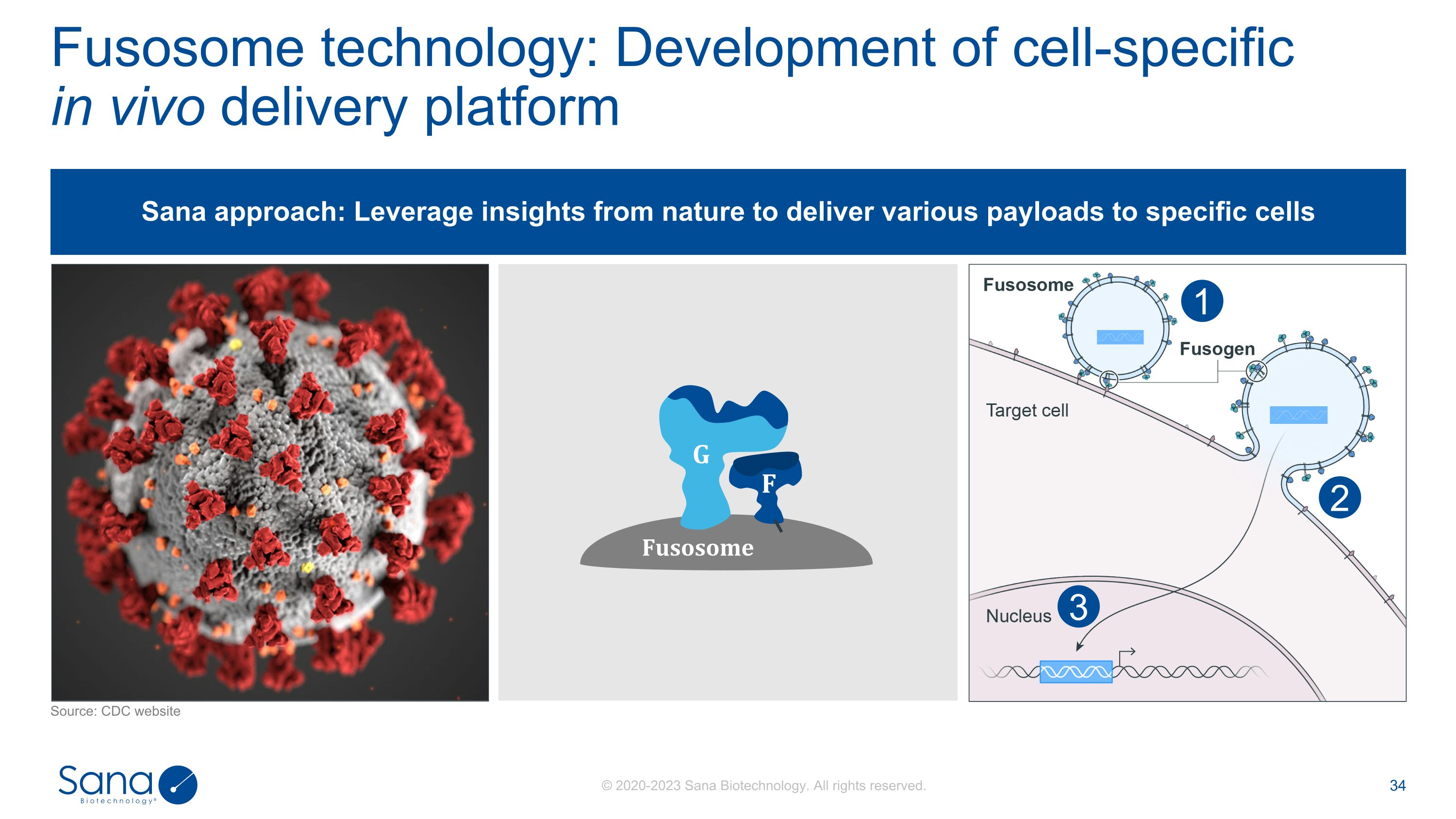
Fusosome technology: Development of cell-specific �in vivo delivery platform Source: CDC website 3 2 1 Sana approach: Leverage insights from nature to deliver various payloads to specific cells F G Fusosome
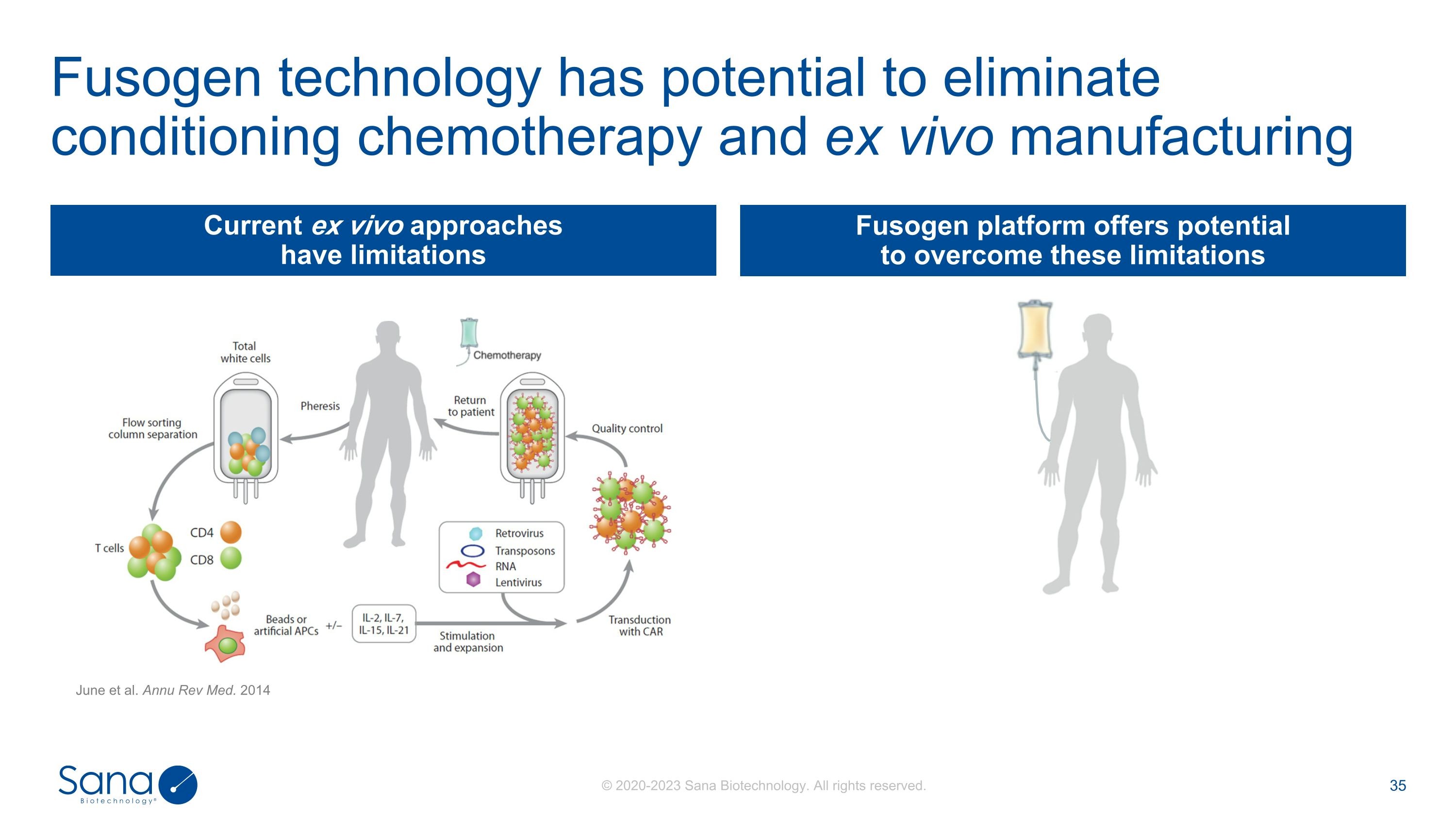
Fusogen technology has potential to eliminate conditioning chemotherapy and ex vivo manufacturing Current ex vivo approaches�have limitations Fusogen platform offers potential �to overcome these limitations June et al. Annu Rev Med. 2014
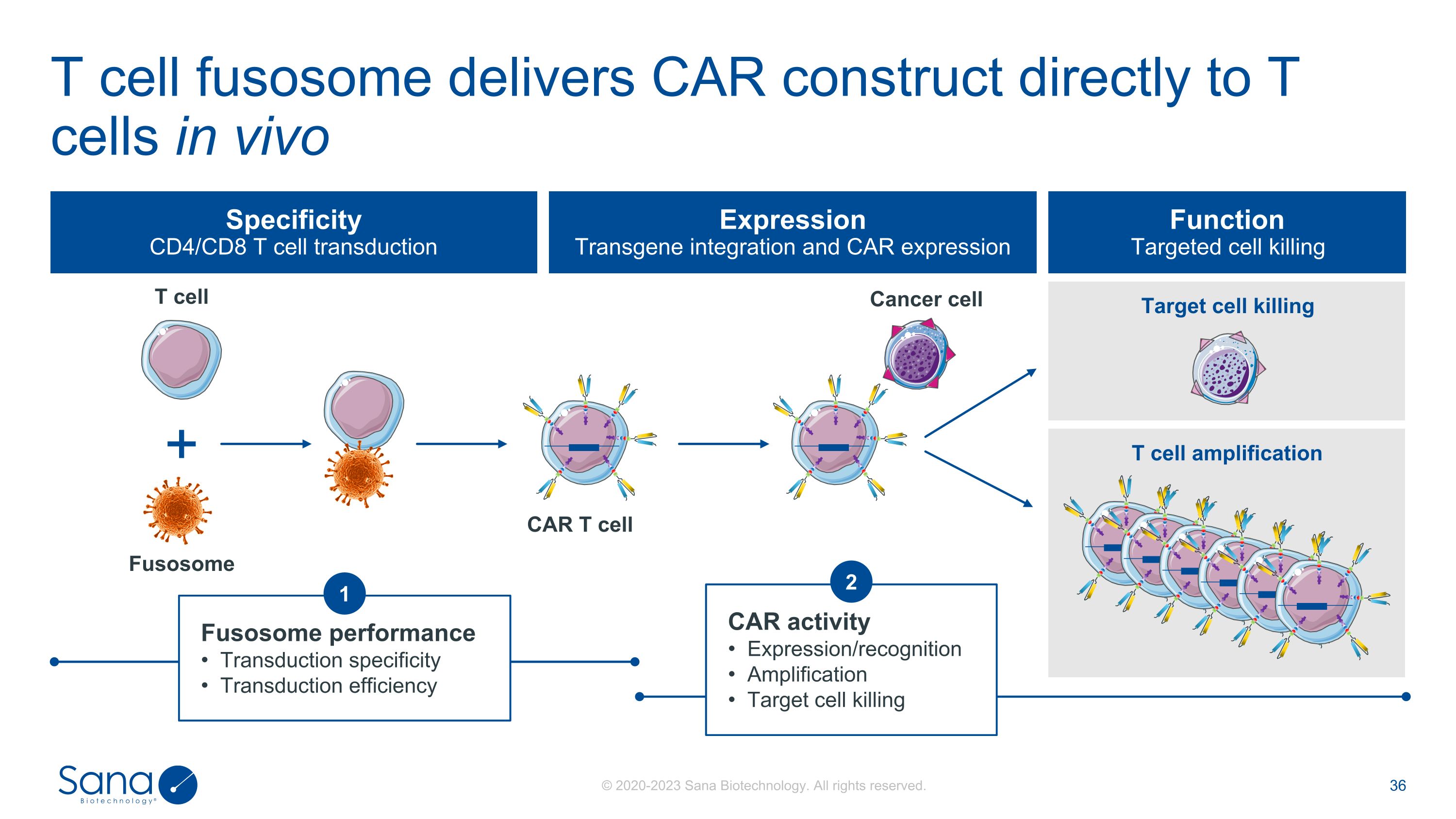
T cell fusosome delivers CAR construct directly to T cells in vivo CAR activity Expression/recognition Amplification Target cell killing Target cell killing T cell amplification Specificity CD4/CD8 T cell transduction Expression Transgene integration and CAR expression Function Targeted cell killing T cell Fusosome Cancer cell CAR T cell 2 Fusosome performance Transduction specificity Transduction efficiency 1
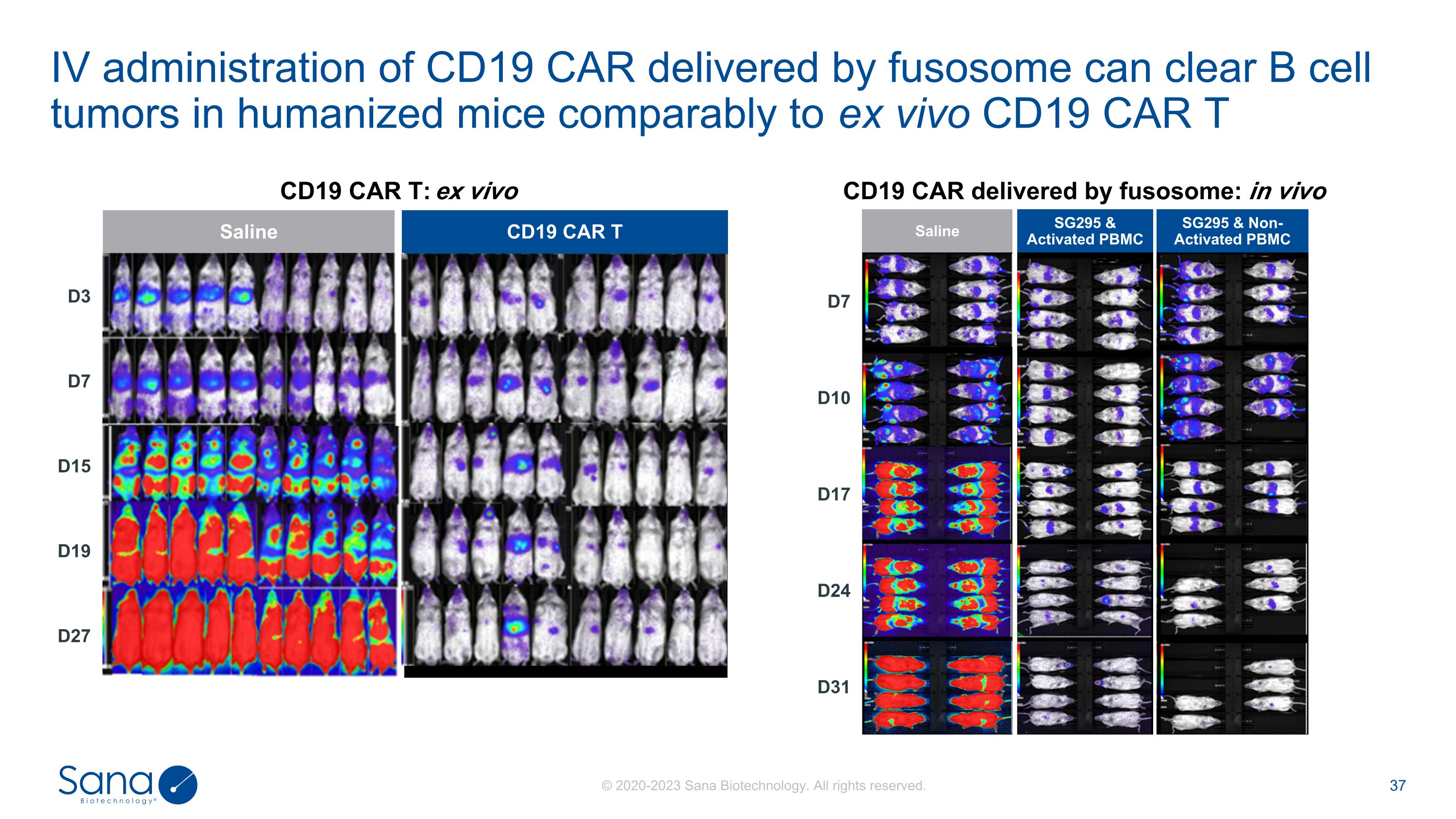
IV administration of CD19 CAR delivered by fusosome can clear B cell tumors in humanized mice comparably to ex vivo CD19 CAR T Saline SG295 & Activated PBMC SG295 & Non-Activated PBMC CD19 CAR delivered by fusosome: in vivo CD19 CAR T: ex vivo Saline CD19 CAR T D3 D7 D15 D19 D27 D7 D10 D17 D24 D31
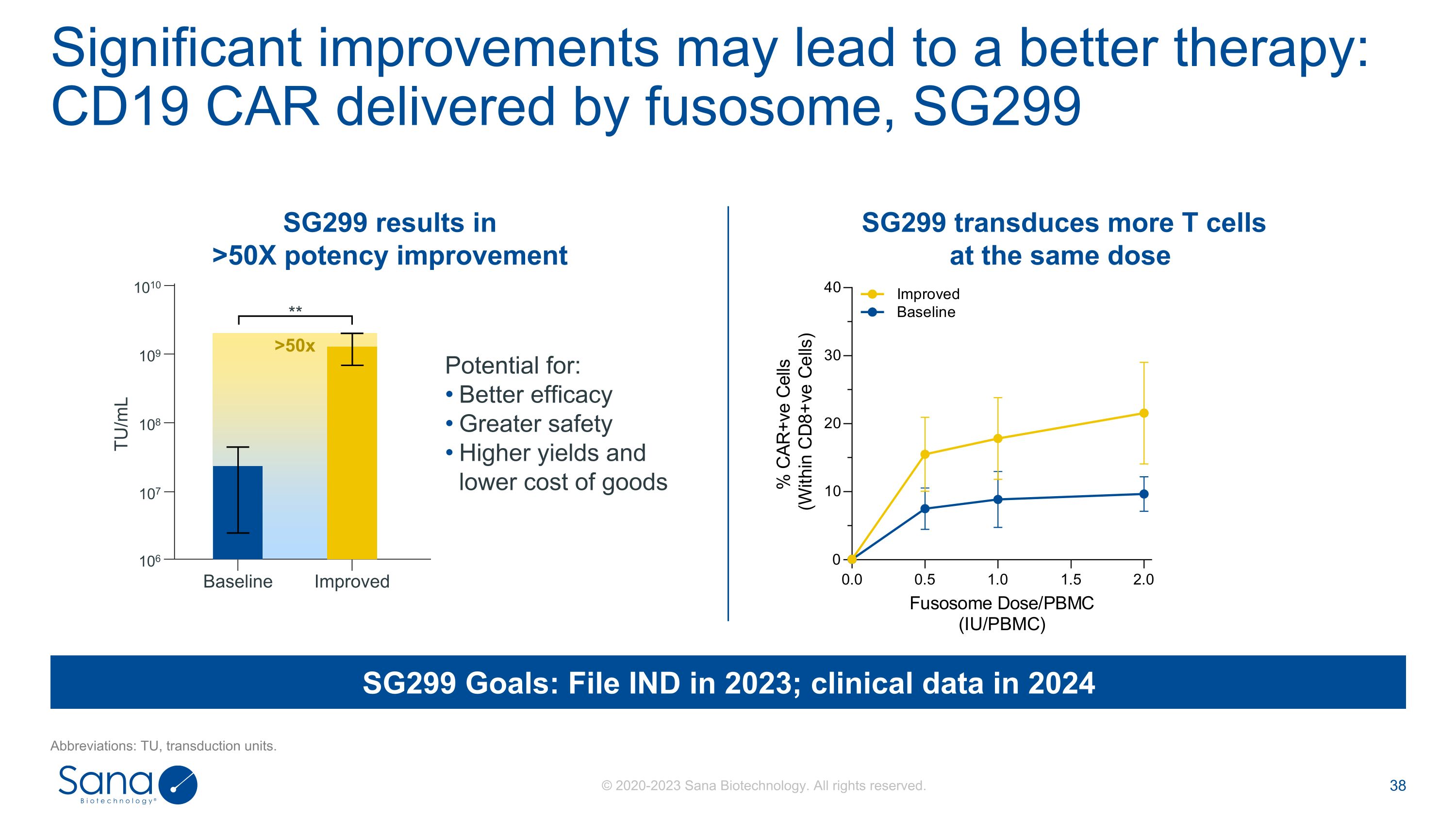
Significant improvements may lead to a better therapy: CD19 CAR delivered by fusosome, SG299 Abbreviations: TU, transduction units. Potential for: Better efficacy Greater safety Higher yields and lower cost of goods SG299 results in�>50X potency improvement SG299 transduces more T cells at the same dose 1010 109 108 107 106 Baseline Improved TU/mL ** >50x SG299 Goals: File IND in 2023; clinical data in 2024
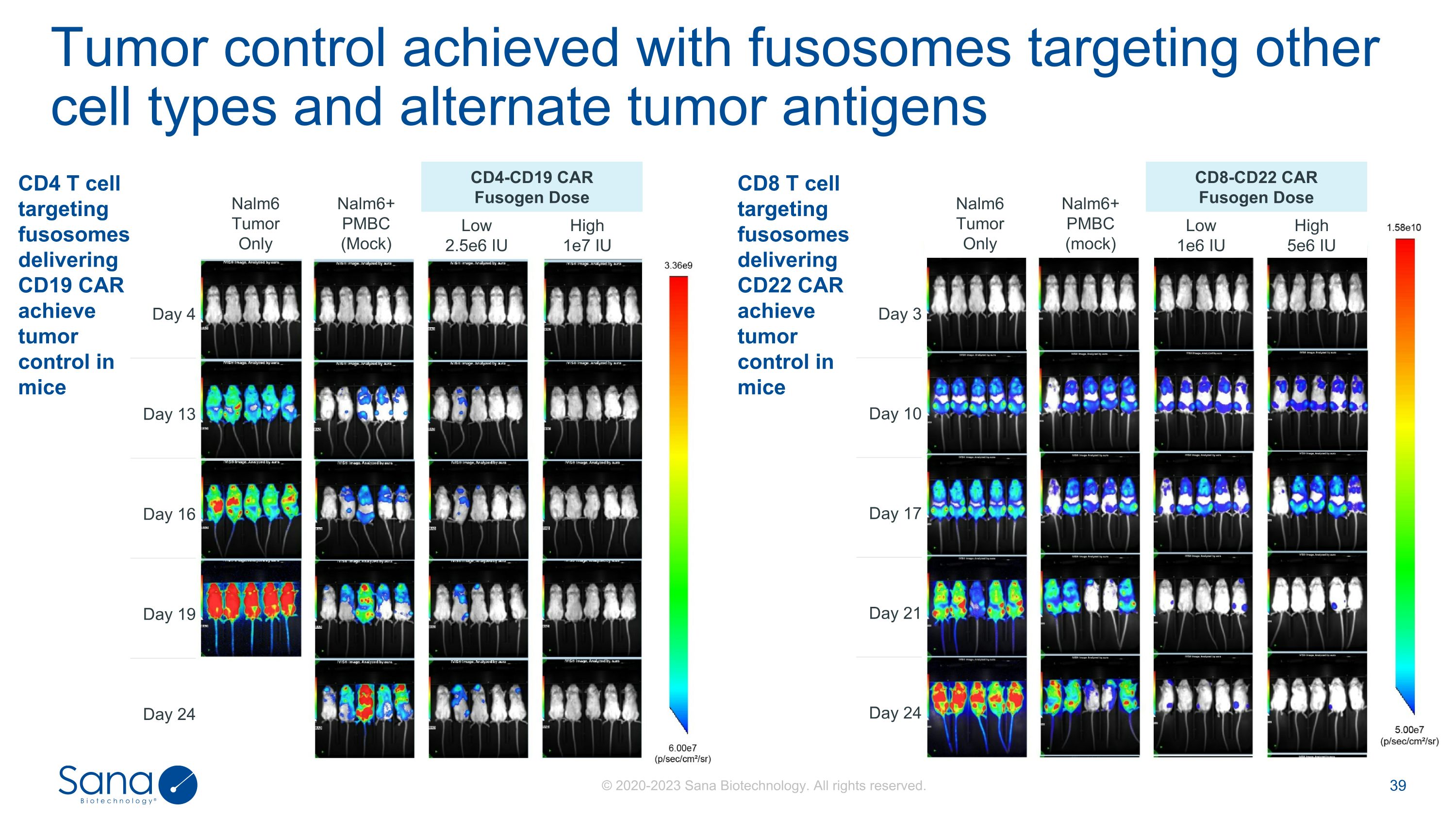
Tumor control achieved with fusosomes targeting other cell types and alternate tumor antigens CD4 T cell targeting fusosomes delivering CD19 CAR achieve tumor control in mice CD8 T cell targeting fusosomes delivering CD22 CAR achieve tumor control in mice Nalm6�Tumor�Only Nalm6+�PMBC�(Mock) CD4-CD19 CAR�Fusogen Dose Low�2.5e6 IU High�1e7 IU Day 4 Day 13 Day 16 Day 19 Day 24 Nalm6�Tumor�Only Nalm6+�PMBC�(mock) CD8-CD22 CAR�Fusogen Dose Low�1e6 IU High�5e6 IU Day 3 Day 10 Day 17 Day 21 Day 24
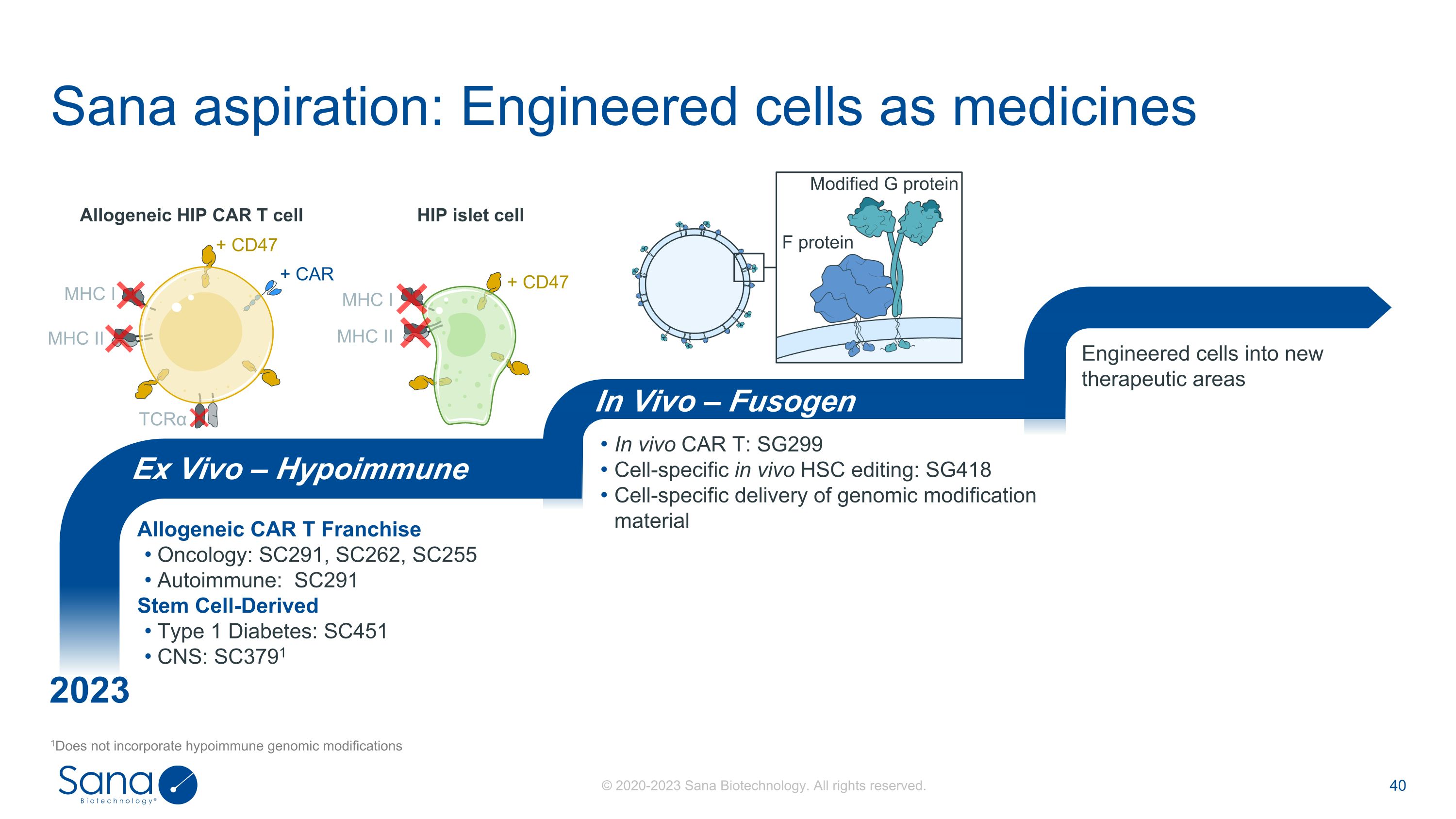
Sana aspiration: Engineered cells as medicines 1Does not incorporate hypoimmune genomic modifications Allogeneic CAR T Franchise Oncology: SC291, SC262, SC255 Autoimmune: SC291 Stem Cell-Derived Type 1 Diabetes: SC451 CNS: SC3791 In vivo CAR T: SG299 Cell-specific in vivo HSC editing: SG418 Cell-specific delivery of genomic modification material Engineered cells into new therapeutic areas Ex Vivo – Hypoimmune In Vivo – Fusogen + CD47 MHC I MHC II Allogeneic HIP CAR T cell HIP islet cell Modified G protein F protein 2023 MHC I MHC II TCRα + CAR + CD47


Appendix
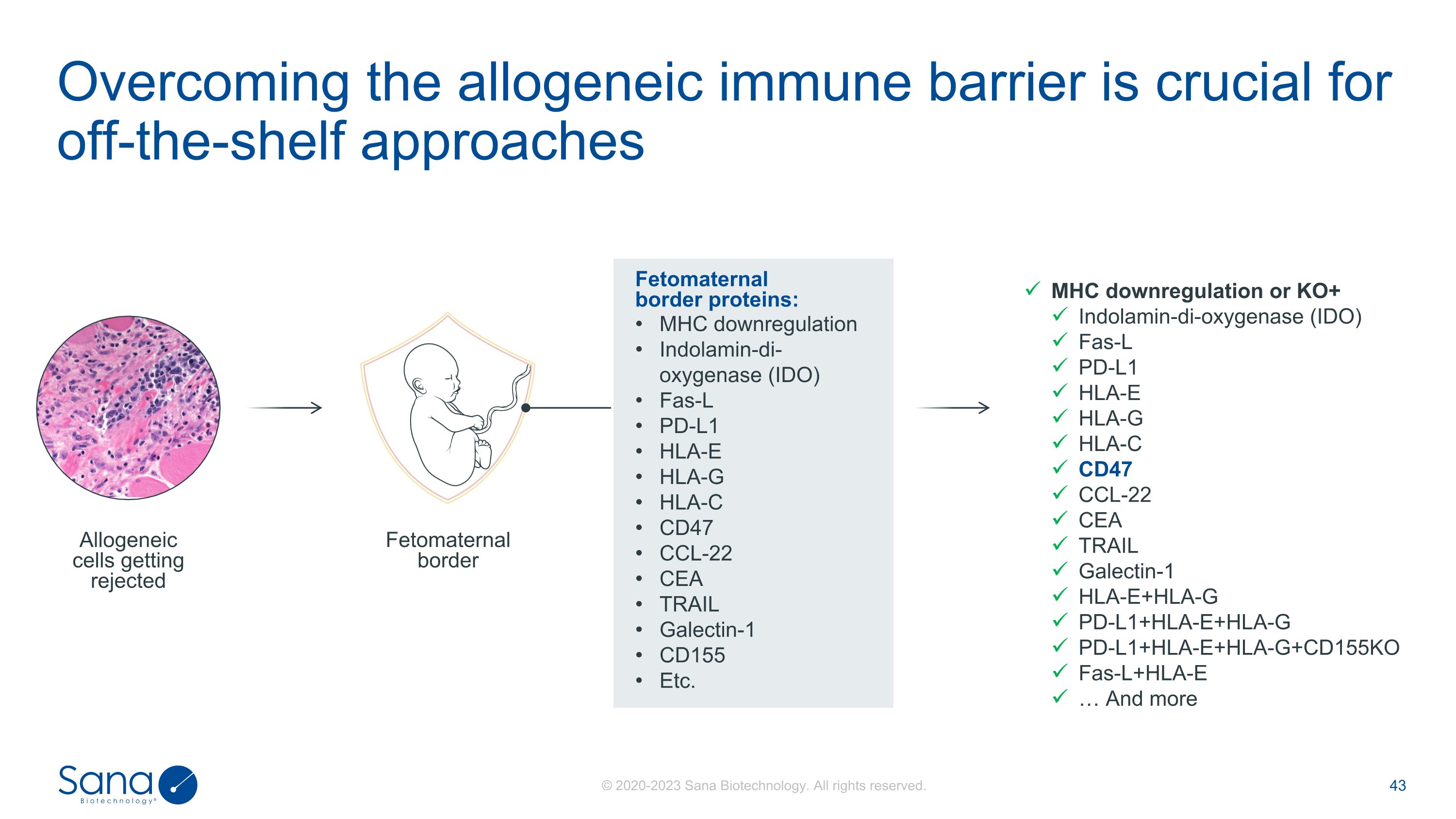
Overcoming the allogeneic immune barrier is crucial for off-the-shelf approaches Fetomaternal �border proteins: MHC downregulation Indolamin-di-oxygenase (IDO) Fas-L PD-L1 HLA-E HLA-G HLA-C CD47 CCL-22 CEA TRAIL Galectin-1 CD155 Etc. MHC downregulation or KO+ Indolamin-di-oxygenase (IDO) Fas-L PD-L1 HLA-E HLA-G HLA-C CD47 CCL-22 CEA TRAIL Galectin-1 HLA-E+HLA-G PD-L1+HLA-E+HLA-G PD-L1+HLA-E+HLA-G+CD155KO Fas-L+HLA-E … And more Allogeneic cells getting rejected Fetomaternal border
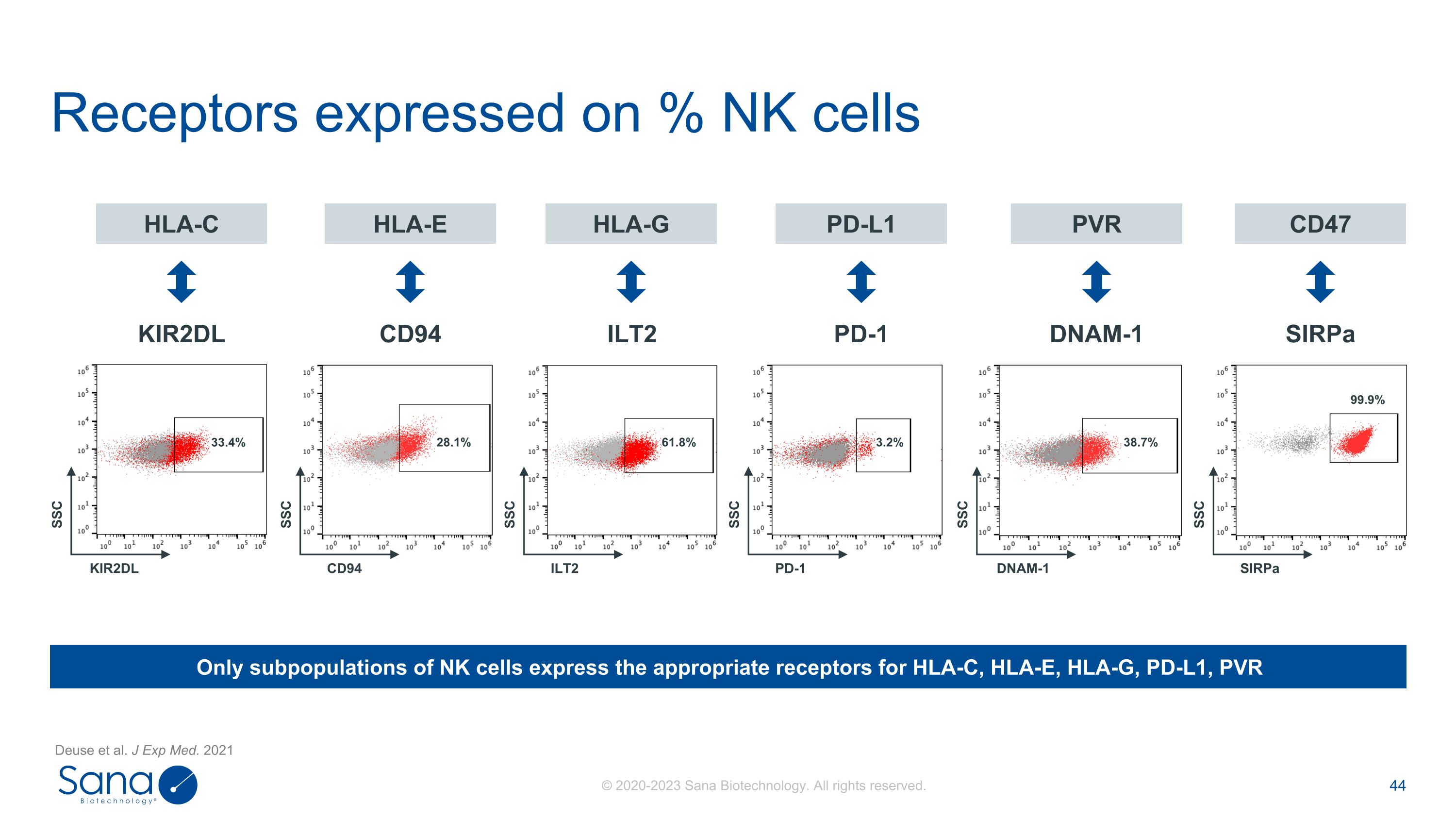
Receptors expressed on % NK cells PD-L1 HLA-E HLA-G HLA-C PVR CD94 CD47 SIRPa DNAM-1 PD-1 ILT2 KIR2DL 33.4% 28.1% 61.8% 3.2% 38.7% Only subpopulations of NK cells express the appropriate receptors for HLA-C, HLA-E, HLA-G, PD-L1, PVR 99.9% SSC KIR2DL SSC CD94 SSC ILT2 SSC PD-1 SSC SIRPa SSC DNAM-1 Deuse et al. J Exp Med. 2021
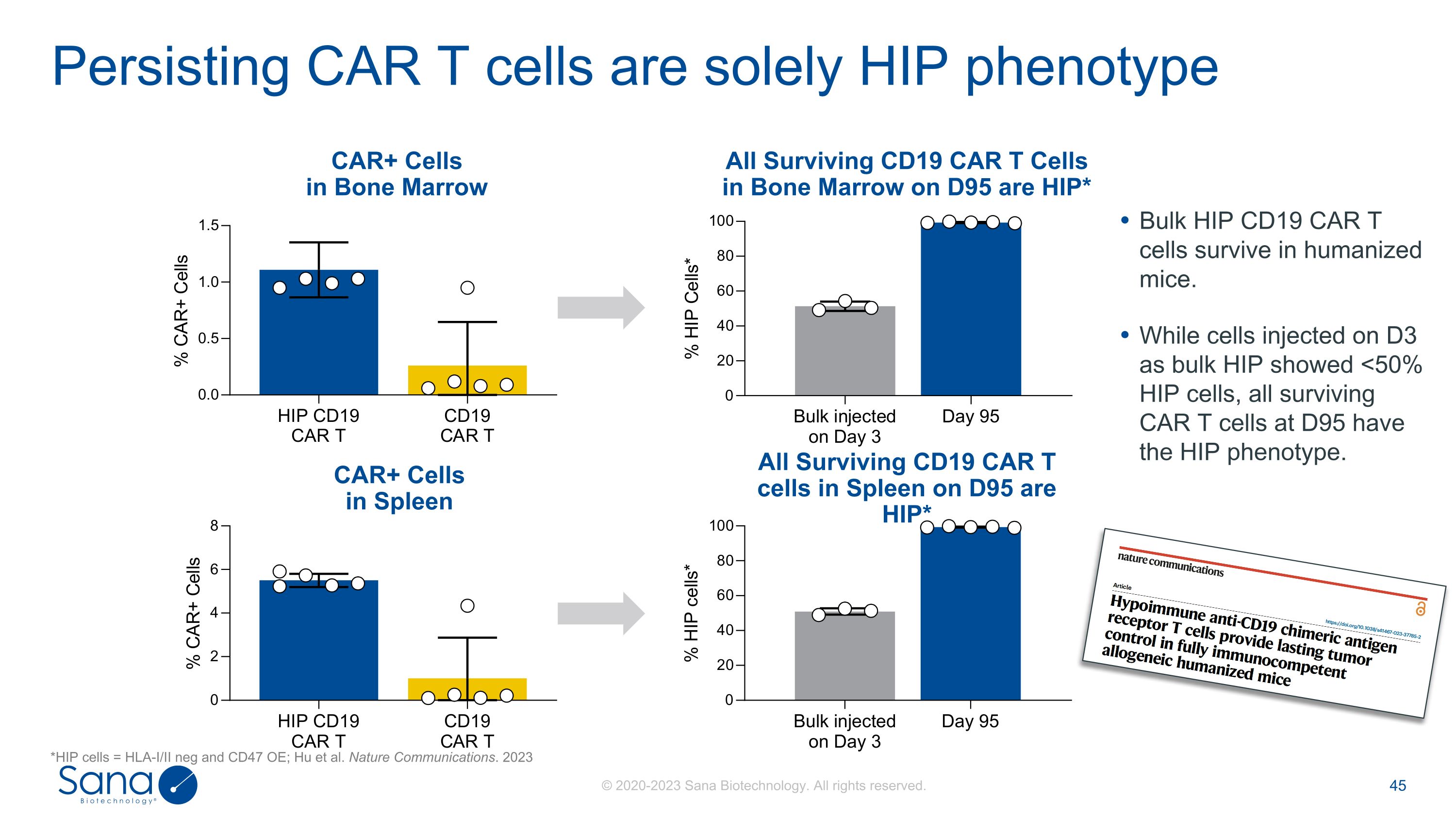
Persisting CAR T cells are solely HIP phenotype *HIP cells = HLA-I/II neg and CD47 OE; Hu et al. Nature Communications. 2023 CAR+ Cells�in Spleen All Surviving CD19 CAR T cells in Spleen on D95 are HIP* CAR+ Cells�in Bone Marrow All Surviving CD19 CAR T Cells in Bone Marrow on D95 are HIP* Bulk HIP CD19 CAR T cells survive in humanized mice. While cells injected on D3 as bulk HIP showed <50% HIP cells, all surviving CAR T cells at D95 have the HIP phenotype.
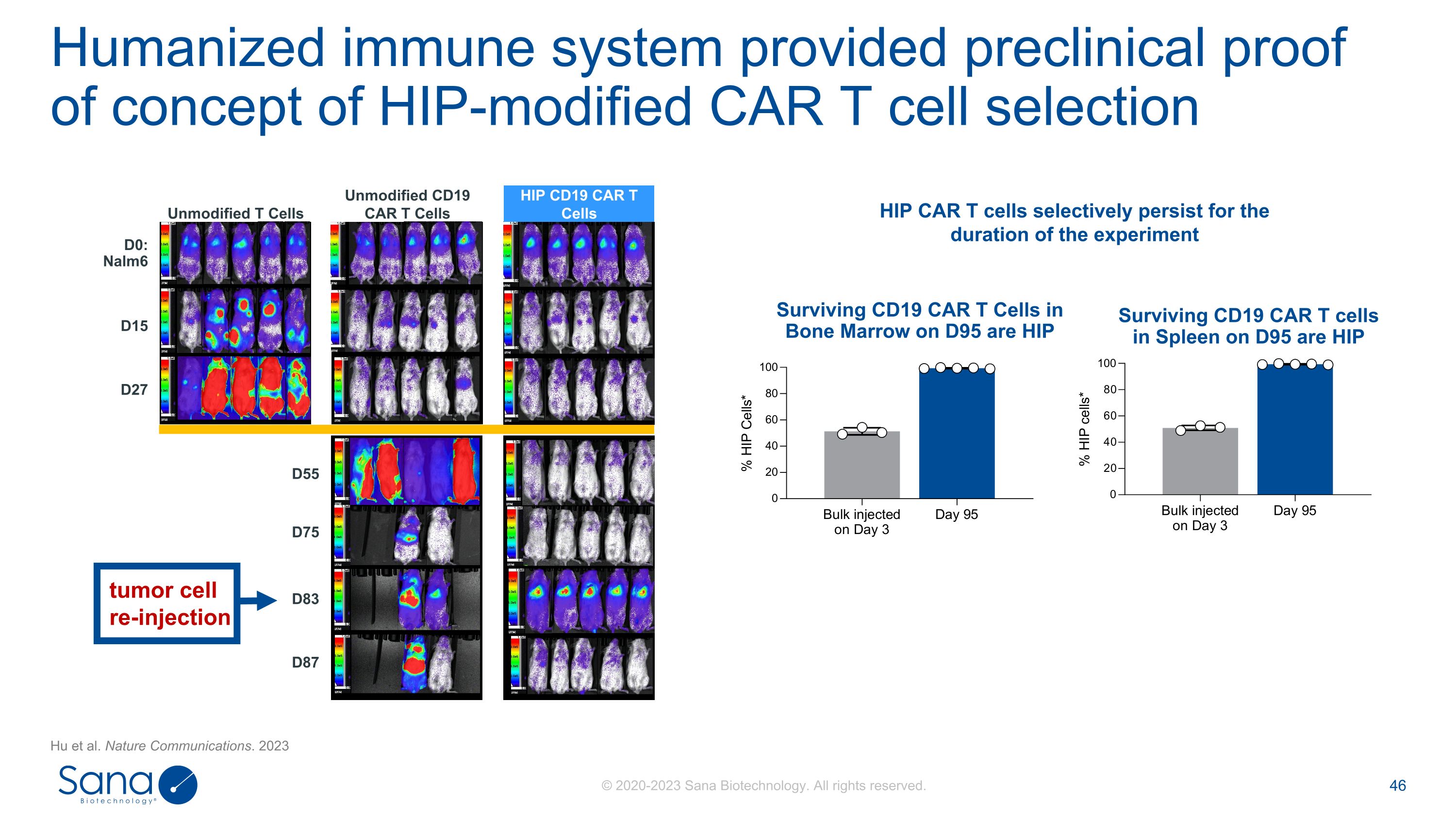
Humanized immune system provided preclinical proof of concept of HIP-modified CAR T cell selection D55 D87 D75 D83 D0:�Nalm6 D15 D27 Unmodified CD19 CAR T Cells Unmodified T Cells HIP CD19 CAR T Cells tumor cell�re-injection Surviving CD19 CAR T cells in Spleen on D95 are HIP Surviving CD19 CAR T Cells in Bone Marrow on D95 are HIP HIP CAR T cells selectively persist for the duration of the experiment Hu et al. Nature Communications. 2023
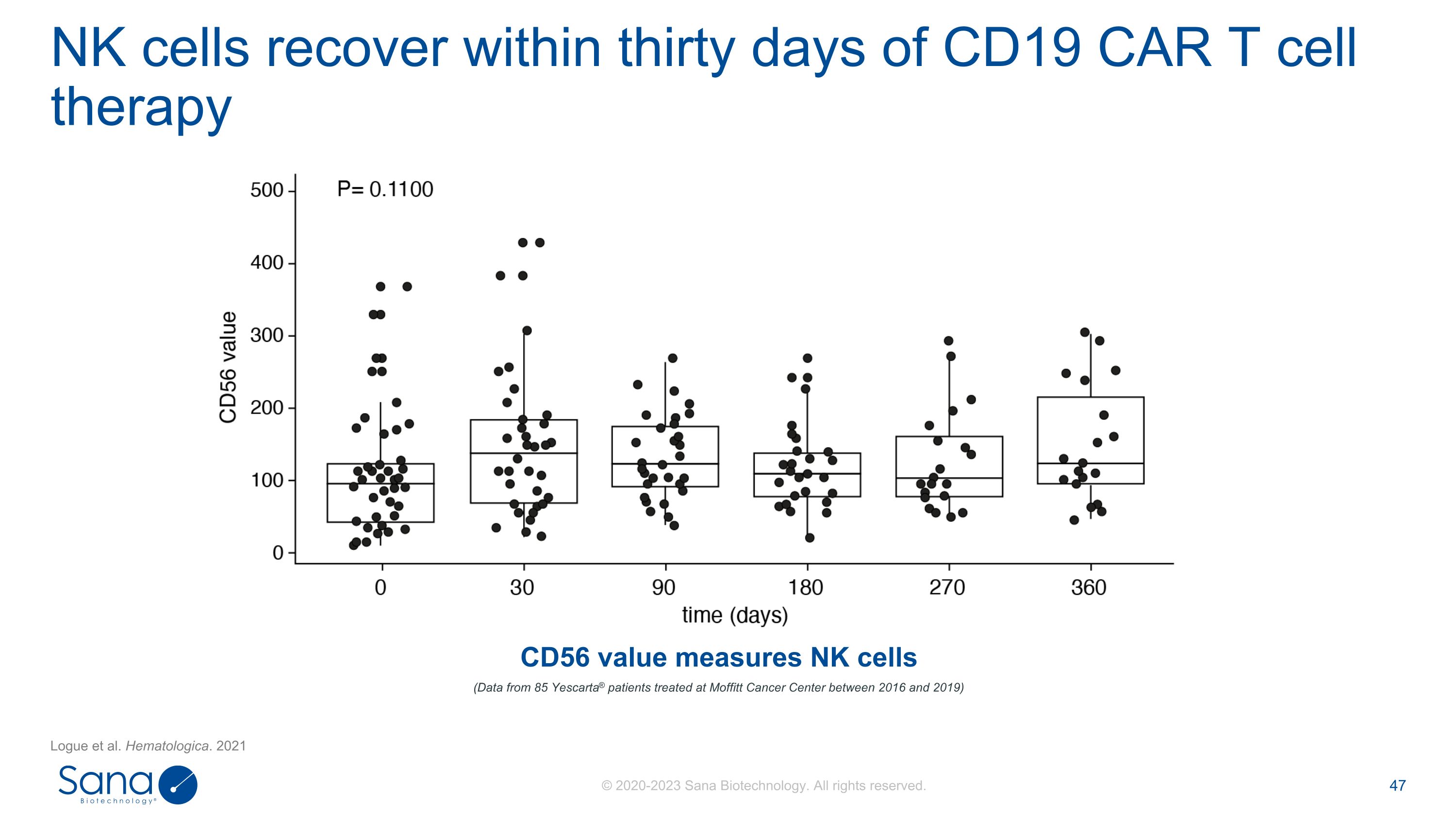
NK cells recover within thirty days of CD19 CAR T cell therapy Logue et al. Hematologica. 2021 (Data from 85 Yescarta® patients treated at Moffitt Cancer Center between 2016 and 2019) CD56 value measures NK cells
v3.23.2
Document and Entity Information
|
Sep. 12, 2023 |
| Cover [Abstract] |
|
| Document Type |
8-K
|
| Amendment Flag |
false
|
| Document Period End Date |
Sep. 12, 2023
|
| Entity Registrant Name |
SANA BIOTECHNOLOGY, INC.
|
| Entity Central Index Key |
0001770121
|
| Entity Emerging Growth Company |
true
|
| Entity Ex Transition Period |
false
|
| Entity File Number |
001-39941
|
| Entity Incorporation, State or Country Code |
DE
|
| Entity Tax Identification Number |
83-1381173
|
| Entity Address, Address Line One |
188 East Blaine Street
|
| Entity Address, Address Line Two |
Suite 400
|
| Entity Address, City or Town |
Seattle
|
| Entity Address, State or Province |
WA
|
| Entity Address, Postal Zip Code |
98102
|
| City Area Code |
206
|
| Local Phone Number |
701-7914
|
| Written Communications |
false
|
| Soliciting Material |
false
|
| Pre-commencement Tender Offer |
false
|
| Pre-commencement Issuer Tender Offer |
false
|
| Title of 12(b) Security |
Common Stock, $0.0001 par value per share
|
| Trading Symbol |
SANA
|
| Security Exchange Name |
NASDAQ
|
| X |
- DefinitionBoolean flag that is true when the XBRL content amends previously-filed or accepted submission.
| Name: |
dei_AmendmentFlag |
| Namespace Prefix: |
dei_ |
| Data Type: |
xbrli:booleanItemType |
| Balance Type: |
na |
| Period Type: |
duration |
|
| X |
- DefinitionFor the EDGAR submission types of Form 8-K: the date of the report, the date of the earliest event reported; for the EDGAR submission types of Form N-1A: the filing date; for all other submission types: the end of the reporting or transition period. The format of the date is YYYY-MM-DD.
| Name: |
dei_DocumentPeriodEndDate |
| Namespace Prefix: |
dei_ |
| Data Type: |
xbrli:dateItemType |
| Balance Type: |
na |
| Period Type: |
duration |
|
| X |
- DefinitionThe type of document being provided (such as 10-K, 10-Q, 485BPOS, etc). The document type is limited to the same value as the supporting SEC submission type, or the word 'Other'.
| Name: |
dei_DocumentType |
| Namespace Prefix: |
dei_ |
| Data Type: |
dei:submissionTypeItemType |
| Balance Type: |
na |
| Period Type: |
duration |
|
| X |
- DefinitionAddress Line 1 such as Attn, Building Name, Street Name
| Name: |
dei_EntityAddressAddressLine1 |
| Namespace Prefix: |
dei_ |
| Data Type: |
xbrli:normalizedStringItemType |
| Balance Type: |
na |
| Period Type: |
duration |
|
| X |
- DefinitionAddress Line 2 such as Street or Suite number
| Name: |
dei_EntityAddressAddressLine2 |
| Namespace Prefix: |
dei_ |
| Data Type: |
xbrli:normalizedStringItemType |
| Balance Type: |
na |
| Period Type: |
duration |
|
| X |
- Definition
+ References
+ Details
| Name: |
dei_EntityAddressCityOrTown |
| Namespace Prefix: |
dei_ |
| Data Type: |
xbrli:normalizedStringItemType |
| Balance Type: |
na |
| Period Type: |
duration |
|
| X |
- DefinitionCode for the postal or zip code
| Name: |
dei_EntityAddressPostalZipCode |
| Namespace Prefix: |
dei_ |
| Data Type: |
xbrli:normalizedStringItemType |
| Balance Type: |
na |
| Period Type: |
duration |
|
| X |
- DefinitionName of the state or province.
| Name: |
dei_EntityAddressStateOrProvince |
| Namespace Prefix: |
dei_ |
| Data Type: |
dei:stateOrProvinceItemType |
| Balance Type: |
na |
| Period Type: |
duration |
|
| X |
- DefinitionA unique 10-digit SEC-issued value to identify entities that have filed disclosures with the SEC. It is commonly abbreviated as CIK. Reference 1: http://www.xbrl.org/2003/role/presentationRef
-Publisher SEC
-Name Exchange Act
-Number 240
-Section 12
-Subsection b-2
| Name: |
dei_EntityCentralIndexKey |
| Namespace Prefix: |
dei_ |
| Data Type: |
dei:centralIndexKeyItemType |
| Balance Type: |
na |
| Period Type: |
duration |
|
| X |
- DefinitionIndicate if registrant meets the emerging growth company criteria. Reference 1: http://www.xbrl.org/2003/role/presentationRef
-Publisher SEC
-Name Exchange Act
-Number 240
-Section 12
-Subsection b-2
| Name: |
dei_EntityEmergingGrowthCompany |
| Namespace Prefix: |
dei_ |
| Data Type: |
xbrli:booleanItemType |
| Balance Type: |
na |
| Period Type: |
duration |
|
| X |
- DefinitionCommission file number. The field allows up to 17 characters. The prefix may contain 1-3 digits, the sequence number may contain 1-8 digits, the optional suffix may contain 1-4 characters, and the fields are separated with a hyphen.
| Name: |
dei_EntityFileNumber |
| Namespace Prefix: |
dei_ |
| Data Type: |
dei:fileNumberItemType |
| Balance Type: |
na |
| Period Type: |
duration |
|
| X |
- DefinitionTwo-character EDGAR code representing the state or country of incorporation.
| Name: |
dei_EntityIncorporationStateCountryCode |
| Namespace Prefix: |
dei_ |
| Data Type: |
dei:edgarStateCountryItemType |
| Balance Type: |
na |
| Period Type: |
duration |
|
| X |
- DefinitionThe exact name of the entity filing the report as specified in its charter, which is required by forms filed with the SEC. Reference 1: http://www.xbrl.org/2003/role/presentationRef
-Publisher SEC
-Name Exchange Act
-Number 240
-Section 12
-Subsection b-2
| Name: |
dei_EntityRegistrantName |
| Namespace Prefix: |
dei_ |
| Data Type: |
xbrli:normalizedStringItemType |
| Balance Type: |
na |
| Period Type: |
duration |
|
| X |
- DefinitionThe Tax Identification Number (TIN), also known as an Employer Identification Number (EIN), is a unique 9-digit value assigned by the IRS. Reference 1: http://www.xbrl.org/2003/role/presentationRef
-Publisher SEC
-Name Exchange Act
-Number 240
-Section 12
-Subsection b-2
| Name: |
dei_EntityTaxIdentificationNumber |
| Namespace Prefix: |
dei_ |
| Data Type: |
dei:employerIdItemType |
| Balance Type: |
na |
| Period Type: |
duration |
|
| X |
- DefinitionLocal phone number for entity.
| Name: |
dei_LocalPhoneNumber |
| Namespace Prefix: |
dei_ |
| Data Type: |
xbrli:normalizedStringItemType |
| Balance Type: |
na |
| Period Type: |
duration |
|
| X |
- DefinitionBoolean flag that is true when the Form 8-K filing is intended to satisfy the filing obligation of the registrant as pre-commencement communications pursuant to Rule 13e-4(c) under the Exchange Act. Reference 1: http://www.xbrl.org/2003/role/presentationRef
-Publisher SEC
-Name Exchange Act
-Number 240
-Section 13e
-Subsection 4c
| Name: |
dei_PreCommencementIssuerTenderOffer |
| Namespace Prefix: |
dei_ |
| Data Type: |
xbrli:booleanItemType |
| Balance Type: |
na |
| Period Type: |
duration |
|
| X |
- DefinitionBoolean flag that is true when the Form 8-K filing is intended to satisfy the filing obligation of the registrant as pre-commencement communications pursuant to Rule 14d-2(b) under the Exchange Act. Reference 1: http://www.xbrl.org/2003/role/presentationRef
-Publisher SEC
-Name Exchange Act
-Number 240
-Section 14d
-Subsection 2b
| Name: |
dei_PreCommencementTenderOffer |
| Namespace Prefix: |
dei_ |
| Data Type: |
xbrli:booleanItemType |
| Balance Type: |
na |
| Period Type: |
duration |
|
| X |
- DefinitionTitle of a 12(b) registered security. Reference 1: http://www.xbrl.org/2003/role/presentationRef
-Publisher SEC
-Name Exchange Act
-Number 240
-Section 12
-Subsection b
| Name: |
dei_Security12bTitle |
| Namespace Prefix: |
dei_ |
| Data Type: |
dei:securityTitleItemType |
| Balance Type: |
na |
| Period Type: |
duration |
|
| X |
- DefinitionName of the Exchange on which a security is registered. Reference 1: http://www.xbrl.org/2003/role/presentationRef
-Publisher SEC
-Name Exchange Act
-Number 240
-Section 12
-Subsection d1-1
| Name: |
dei_SecurityExchangeName |
| Namespace Prefix: |
dei_ |
| Data Type: |
dei:edgarExchangeCodeItemType |
| Balance Type: |
na |
| Period Type: |
duration |
|
| X |
- DefinitionBoolean flag that is true when the Form 8-K filing is intended to satisfy the filing obligation of the registrant as soliciting material pursuant to Rule 14a-12 under the Exchange Act. Reference 1: http://www.xbrl.org/2003/role/presentationRef
-Publisher SEC
-Name Exchange Act
-Section 14a
-Number 240
-Subsection 12
| Name: |
dei_SolicitingMaterial |
| Namespace Prefix: |
dei_ |
| Data Type: |
xbrli:booleanItemType |
| Balance Type: |
na |
| Period Type: |
duration |
|
| X |
- DefinitionTrading symbol of an instrument as listed on an exchange.
| Name: |
dei_TradingSymbol |
| Namespace Prefix: |
dei_ |
| Data Type: |
dei:tradingSymbolItemType |
| Balance Type: |
na |
| Period Type: |
duration |
|
| X |
- DefinitionBoolean flag that is true when the Form 8-K filing is intended to satisfy the filing obligation of the registrant as written communications pursuant to Rule 425 under the Securities Act. Reference 1: http://www.xbrl.org/2003/role/presentationRef
-Publisher SEC
-Name Securities Act
-Number 230
-Section 425
| Name: |
dei_WrittenCommunications |
| Namespace Prefix: |
dei_ |
| Data Type: |
xbrli:booleanItemType |
| Balance Type: |
na |
| Period Type: |
duration |
|
Sana Biotechnology (NASDAQ:SANA)
Historical Stock Chart
From Mar 2024 to Apr 2024
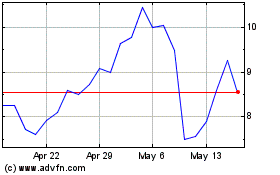
Sana Biotechnology (NASDAQ:SANA)
Historical Stock Chart
From Apr 2023 to Apr 2024
